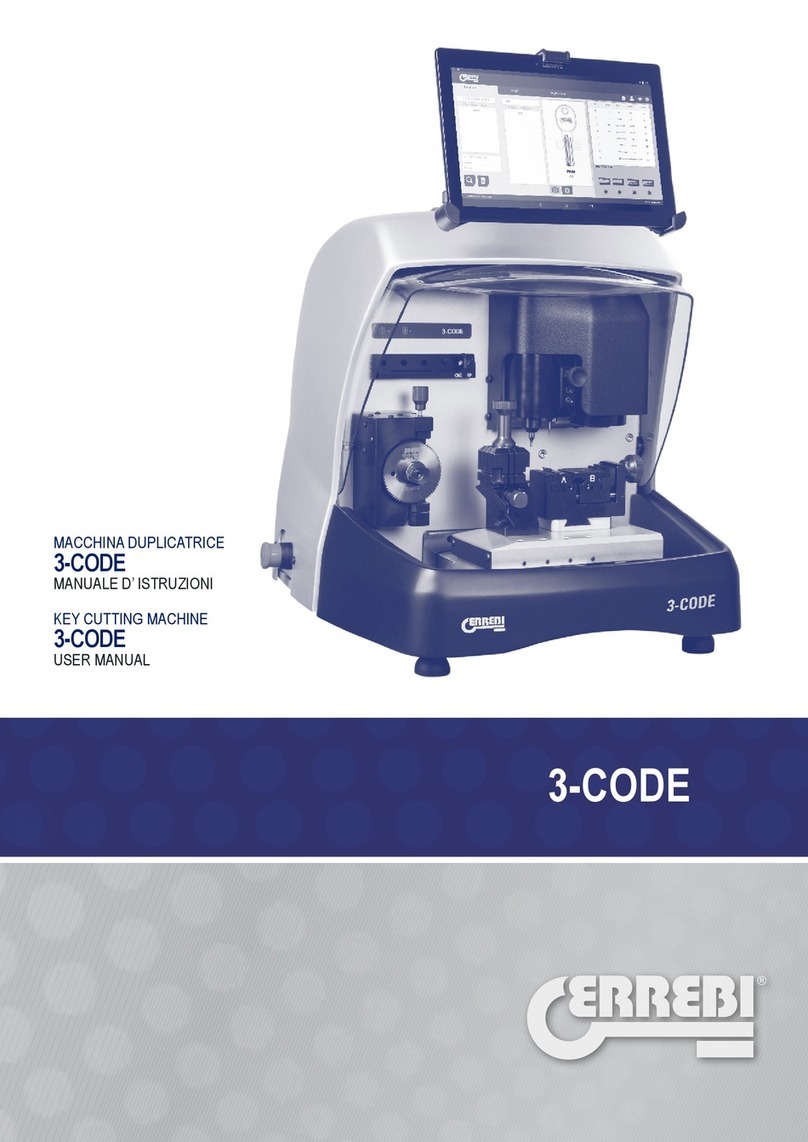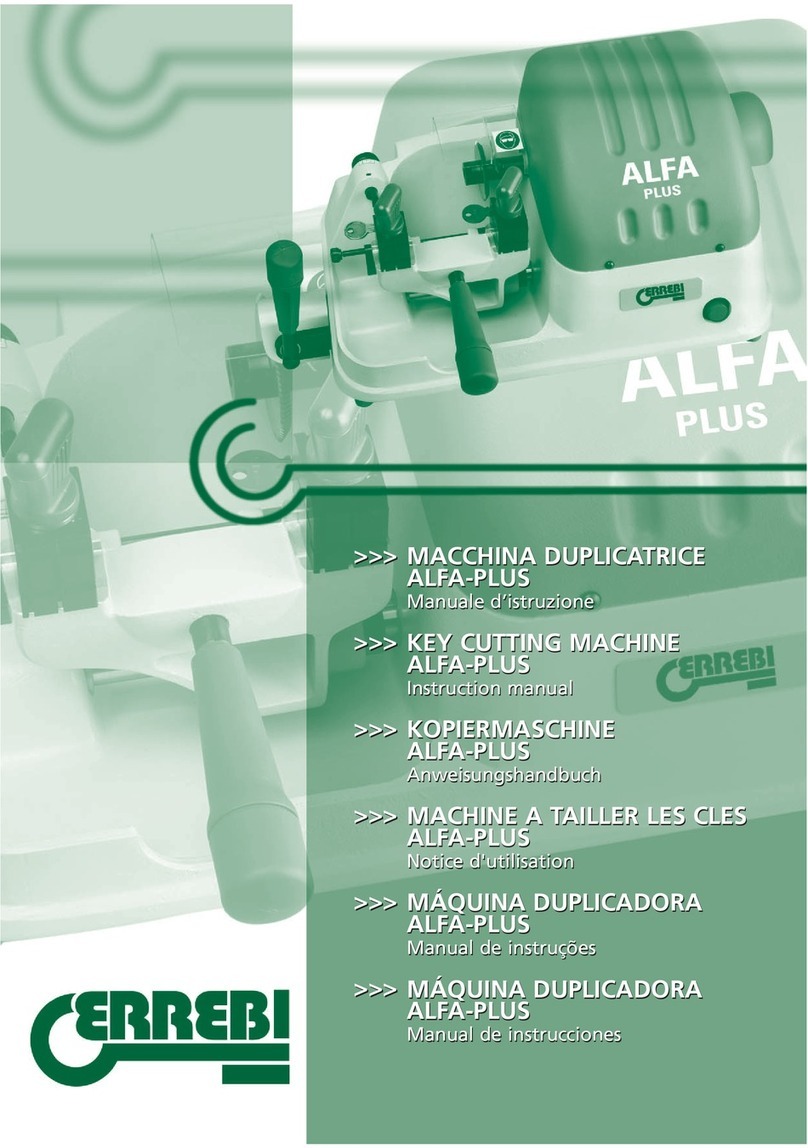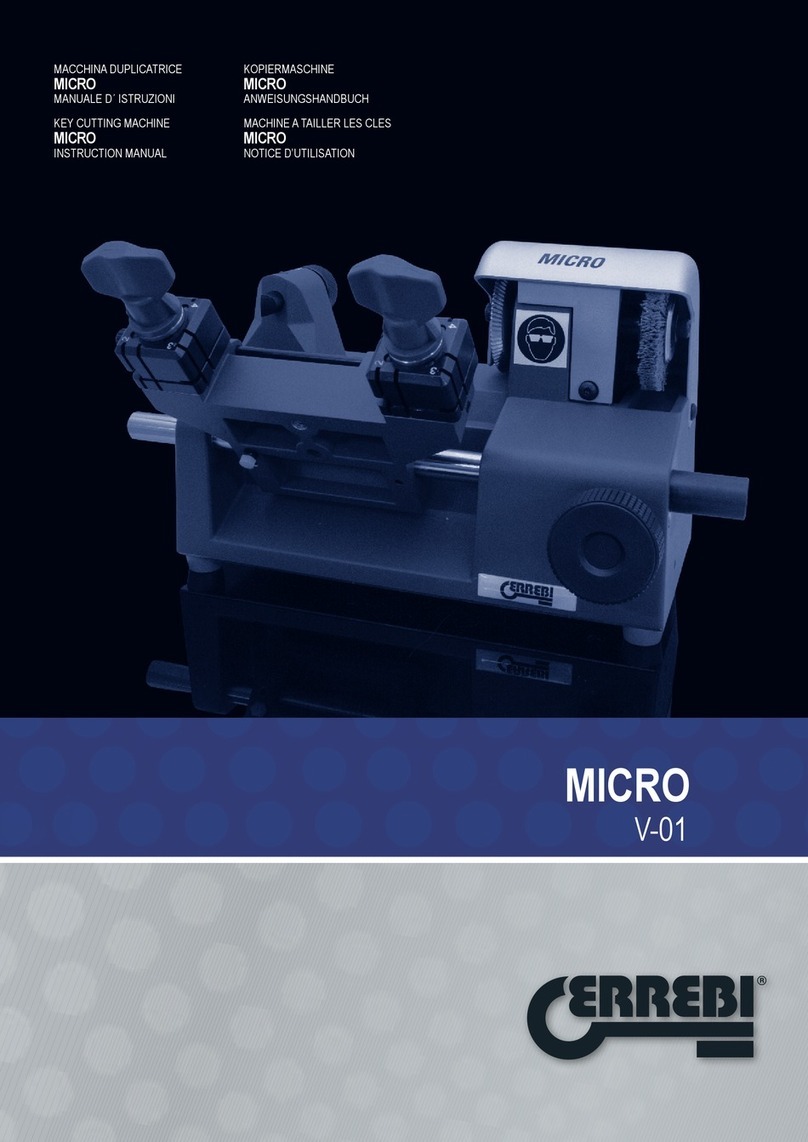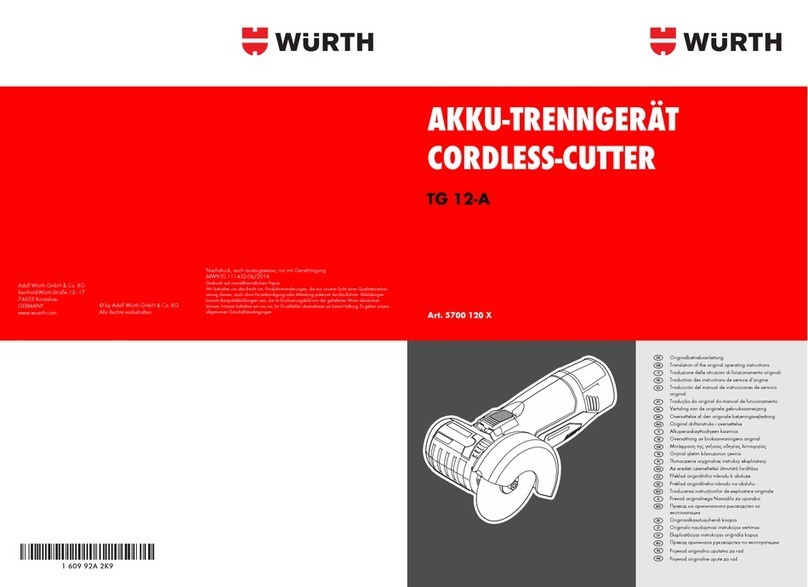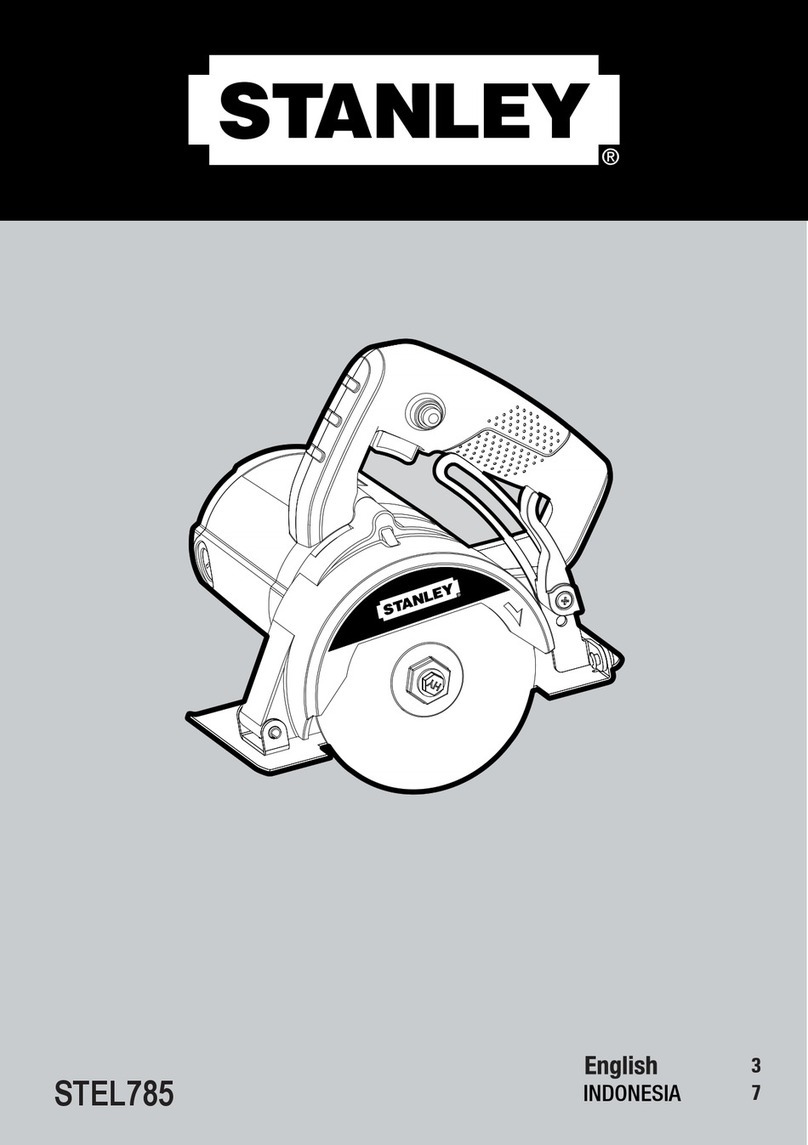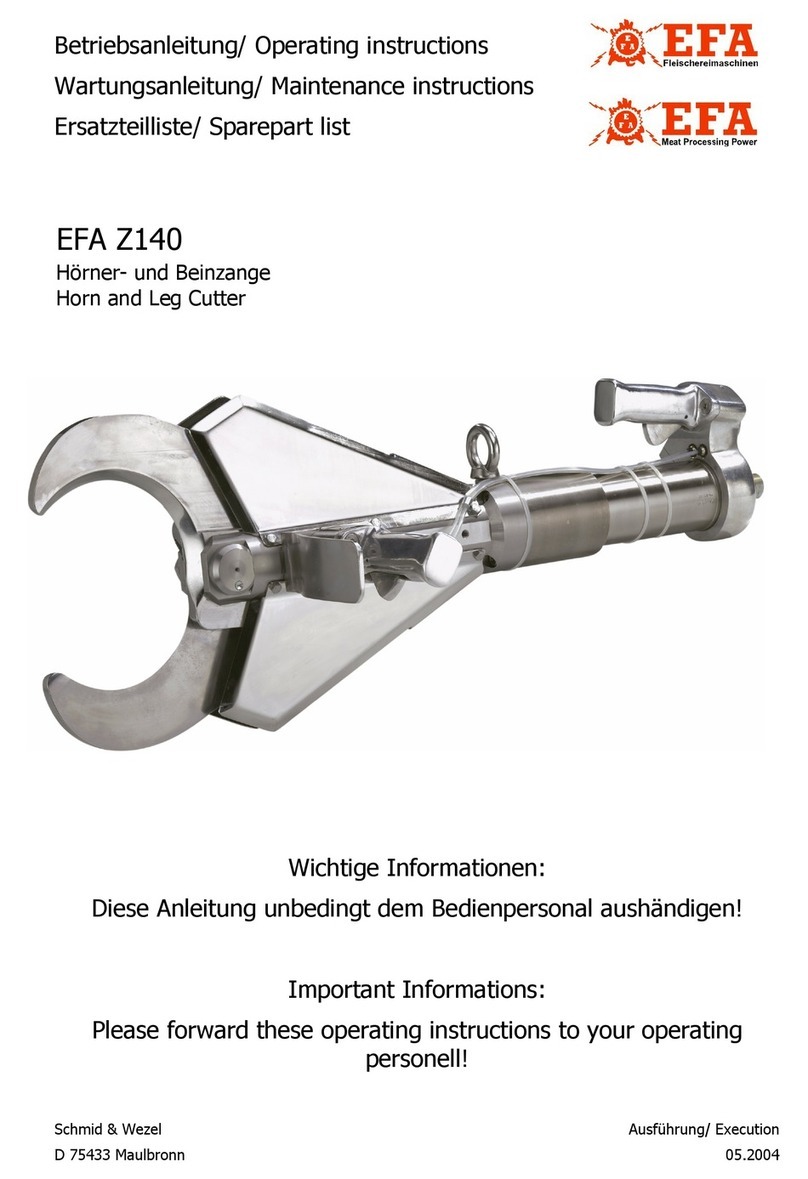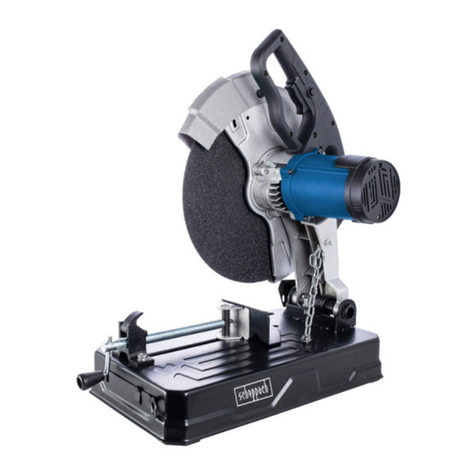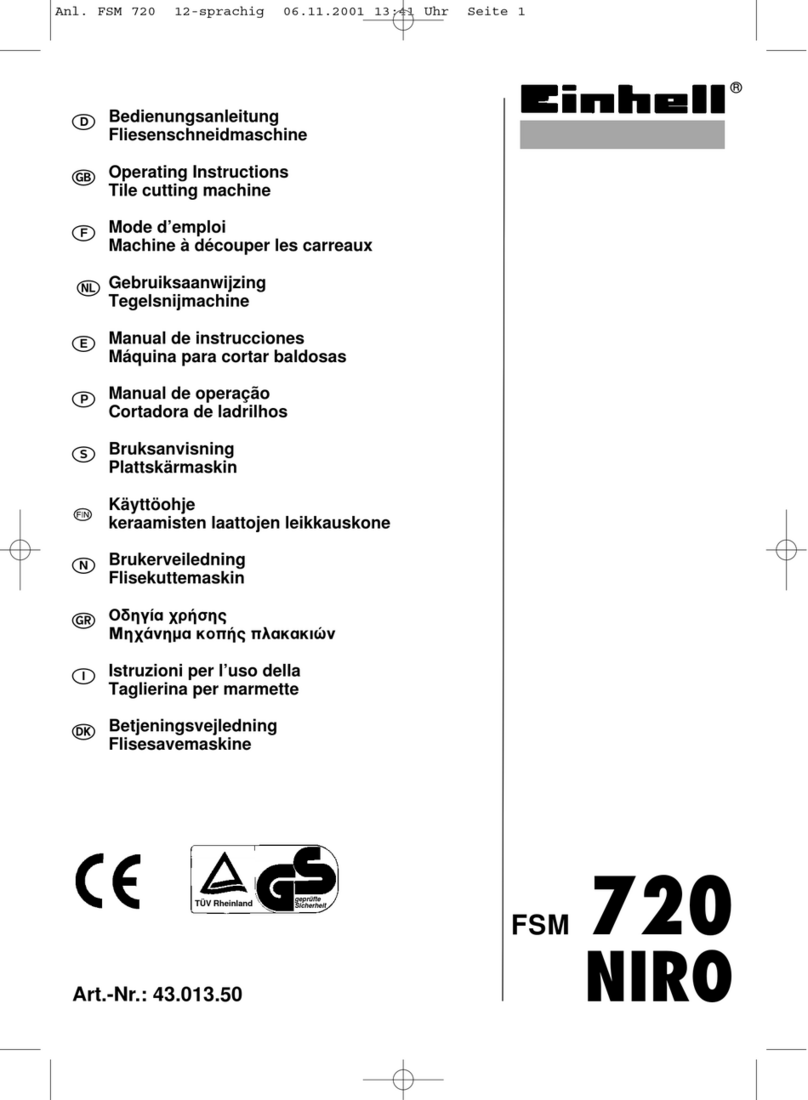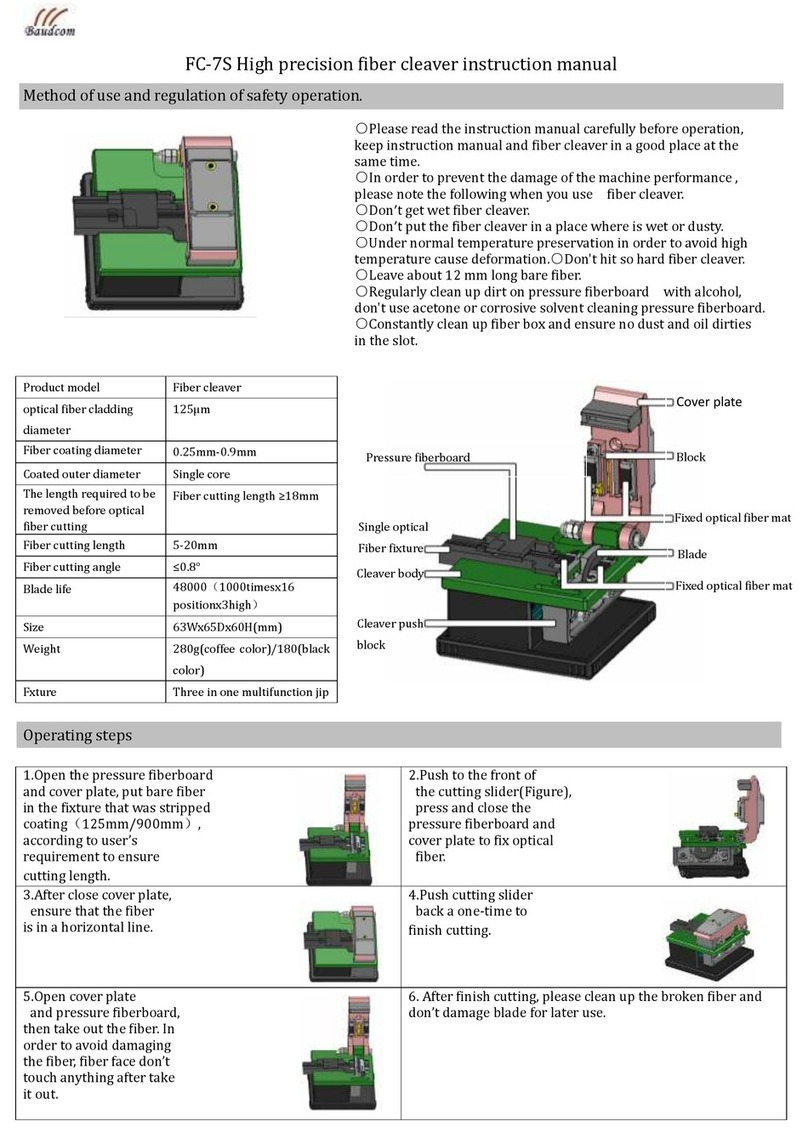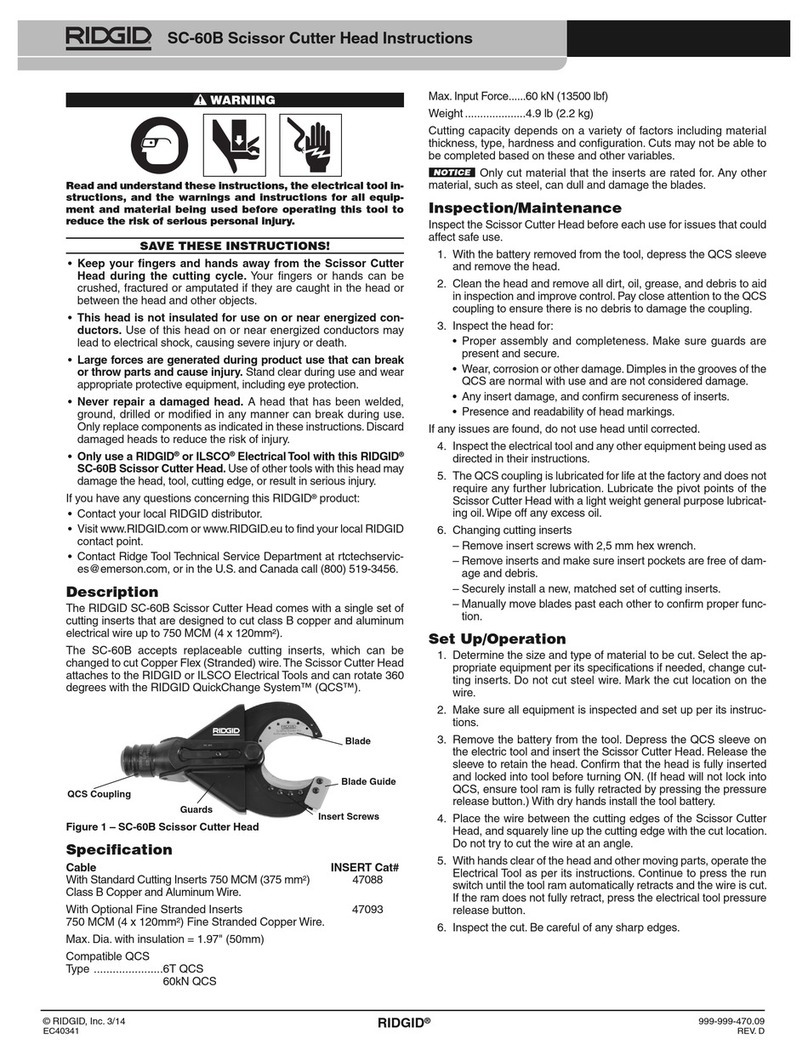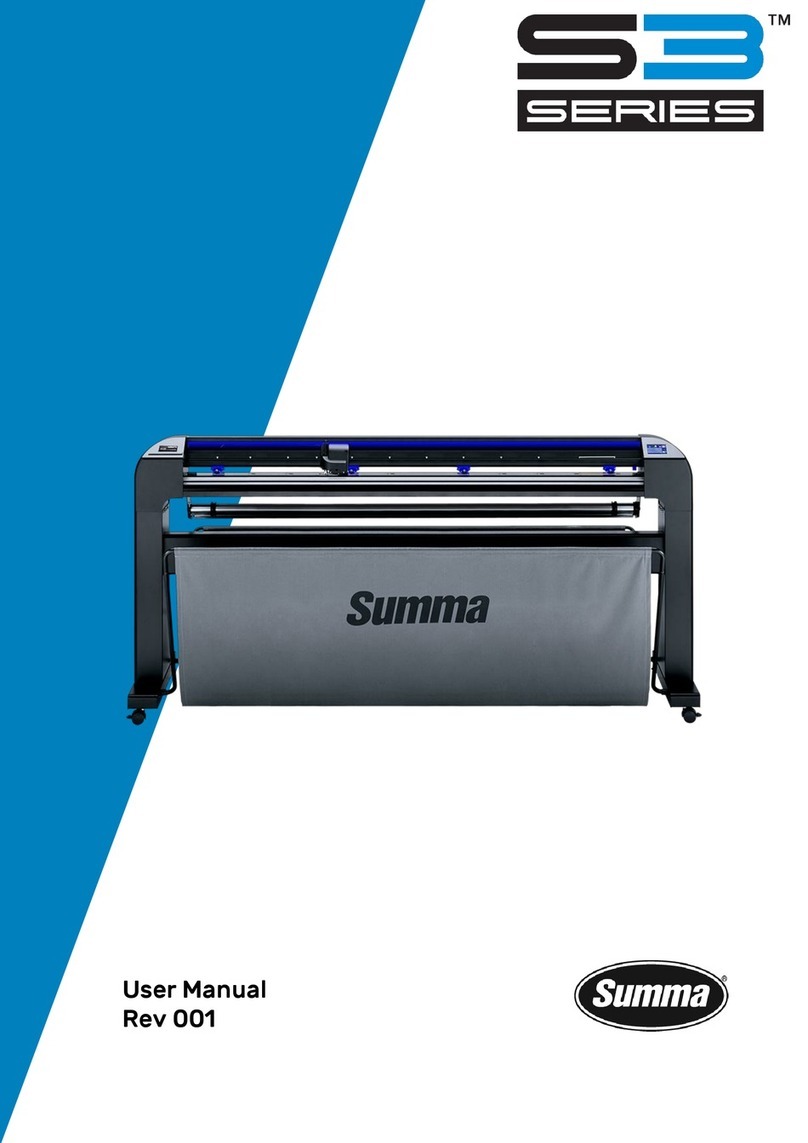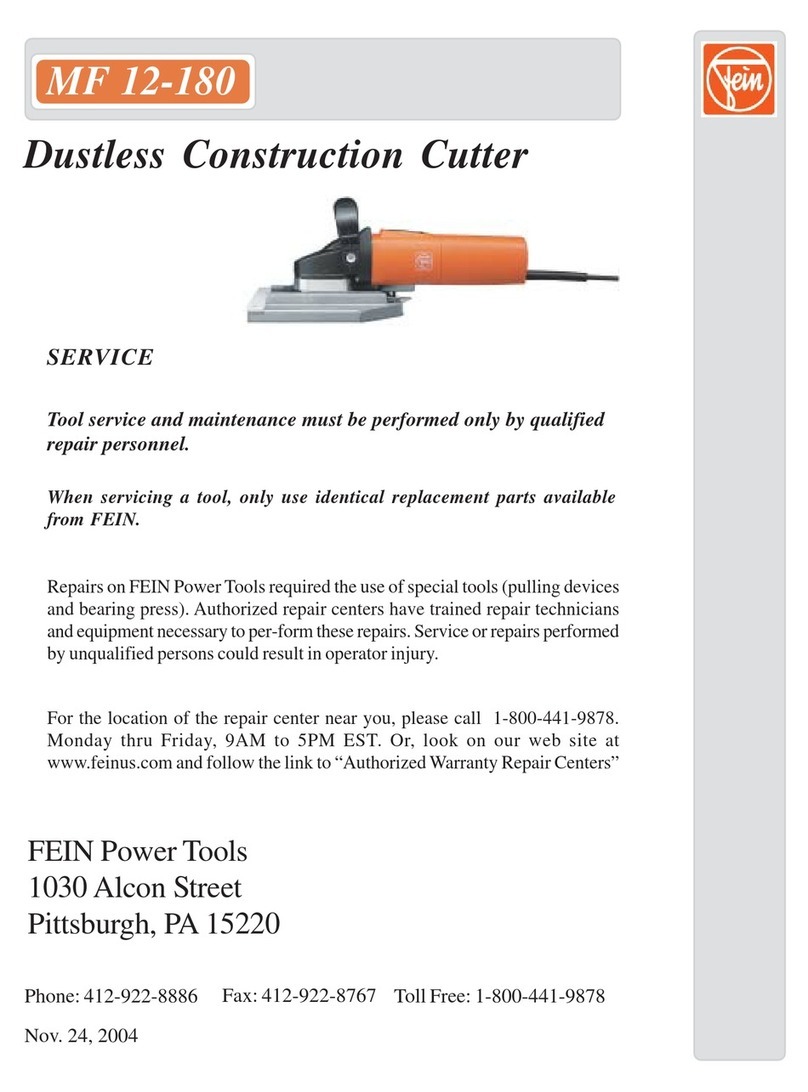Errebi DAKAR EVOLUTION User manual

MACCHINA DUPLICATRICE DI CHIAVI
DAKAR EVOLUTION
MANUALE D’ISTRUZIONI
KEY CUTTING MACHINE
DAKAR EVOLUTION
INSTRUCTION MANUAL
MACHINE DUPLICATRICE
DAKAR EVOLUTION
NOTICE D’UTILISATION
DUPLIZIERMASCHINE
DAKAR EVOLUTION
BEDIENUNGSANLEITUNG
MÁQUINA DUPLICADORA
DAKAR EVOLUTION
MANUAL DE INSTRUCCIONES
NØGLEMASKINE
DAKAR EVOLUTION
BRUGSANVISNING
DAKAR EVOLUTION

ITALIANO
DAKAR
EVOLUTI0N
MANUALE D’ISTRUZIONI
MACCHINA DUPLICATRICE DI CHIAVI

ITALIANO
1.- PRESENTAZIONE E ASPETTI GENERALI
1.1 GENERALITÀ
1.2 IMBALLAGGIO E TRASPORTO
1.3 ETICHETTA IDENTIFICATIVA
2. - CARATTERISTICHE DELLA MACCHINA
2.1 TIPI DI CHIAVI
2.2 ACCESSORI
2.3 MAGAZZINO UTENSILI
2.4 CIRCUITO ELETTRICO
2.5 DATI TECNICI
2.6 ELEMENTI PRINCIPALI DELLA MACCHINA
2.7 COMPONENTI E PARTI FUNZIONALI
2.7.1 CAMBIO DI FRESA E DI TASTATORE (21)
2.7.2 BLOCCAGGIO DEL CARRELLO ALLA FINE DELLA CORSA DELL’ASSE “Y”
2.7.3 MORSETTO (6)
2.7.4 MOLLEGGIO DEL TASTATORE (11)
2.7.5 MOLLEGGIO E BLOCCAGGIO DEL CARRELLO SULL’ASSE “X“ (5 E 4)
2.7.6 LEVA DI SOSTEGNO PER CHIAVI TUBOLARI
2.7.7 VELOCITÀ DELLA FRESA (17)
2.7.8 DISPLAY-TASTIERA (1)
2.7.9 TARATURA VERTICALE DEL TASTATORE (15)
2.7.10 CONTROLLO DELLA FORZA DI DUPLICAZIONE
3.- CIFRATURA
3.1 PROCEDURA DI CIFRATURA
3.2 CIFRATURA DELLE CHIAVI
3.2.1 CHIAVI KB2, KB4 E KB5.
3.2.2 CHIAVE KC1.
3.2.3 CHIAVE SE1L
3.2.4 CHIAVI HF42P15 E YM22P15
3.2.5 CHIAVI HF40P18 E HF38P17
3.2.6 CHIAVI TUBOLARI
3.2.7 CHIAVI FC6 E FC120
3.2.8 CHIAVI TK23, TK24 E TK25
3.2.9 CHIAVE JIS4P
3.2.10 CHIAVE TB1P5
3.2.11 CHIAVE MD13R
3.2.12 CHIAVE TS14 E TS12
4.- MANUTENZIONE
4.1 SOSTITUZIONE DELLE GANASCE DEL MORSETTO
4.2 TARATURA DELLE GANASCE
4.2.1 TARATURA NORMALE
4.2.2 TARATURA DI PRECISIONE
4.3 SOSTITUZIONE DEI FUSIBILI
4.4 TENSIONAMENTO E SOSTITUZIONE DELLA CINGHIA
4.5 SOSTITUZIONE DEL MOTORE
4.6 SOSTITUZIONE DEL DISPLAY-TASTIERA
4.7 SOSTITUZIONE DELLA SCHEDA ELETTRONICA DI CONTROLLO
4.8 SOSTITUZIONE DELLA SCHEDA DI POTENZA E DEL DISGIUNTORE
5.- SICUREZZA
6.- SMALTIMENTO DEI RIFIUTI
6.1 IMBALLAGGIO
6.2 TRUCIOLI
6.3 MACCHINA
7.- TABELLA CHIAVE-FRESA-TASTATORE-INCLINAZIONE-ADATTATORE
8.- ESPLOSO

ITALIANO
1.- PRESENTAZIONE E ASPETTI GENERALI
1.1 GENERALITÀ
La macchina duplicatrice di chiavi DAKAR EVOLUTION è stata progettata tenendo conto
delle norme di sicurezza vigenti nella C.E.E.
La sicurezza del personale addetto al funzionamento di questo tipo di macchine si ot-
tiene esclusivamente con un programma ben progettato in fatto di sicurezza personale,
eseguendo regolarmente la manutenzione e seguendo i consigli forniti, nonché con il
rispetto delle norme di sicurezza riportate in questo manuale.
Anche se l’installazione della macchina non presenta alcuna difficoltà, è preferibile non
cercare di installarla, di regolarla o di usarla senza aver letto prima questo manuale.
La macchina esce dalle nostre strutture pronta per l’uso ed è solo necessario eseguire
le operazioni di taratura degli utensili da usare.
1.2 IMBALLAGGIO E TRASPORTO
La macchina è imballata in una robusta scatola di cartone protetta con schiuma da
imballaggio, con le seguenti dimensioni:
Larghezza = 520 mm; Altezza = 650 mm; Profondità = 575 mm
Peso della macchina con l’imballaggio = 30 Kg
Durante il disimballo della macchina, ispezionare accuratamente la macchina per accer-
tarsi che non abbia subito danni durante il trasporto.
Se venisse rilevata qualche anomalia, avvertire immediatamente il trasportatore e non
usare la macchina prima che l’agente del trasportatore esegua la relativa ispezione.
Per spostare la macchina da un posto all’altro, afferrarla dalla base e non da altre parti.
1.3 ETICHETTA IDENTIFICATIVA
La macchina duplicatrice di chiavi DAKAR EVO-
LUTION è munita di etichetta identificativa,
nella quale sono riportati il numero di serie, il
nome e l’indirizzo del costruttore, il marchio CE
e l’anno di fabbricazione.
2. - CARATTERISTICHE DELLA MACCHINA
La macchina DAKAR EVOLUTION è una duplicatrice molto robusta e di grande precisio-
ne, caratterizzata dalle molteplici possibilità di fissaggio consentito dal morsetto, senza
necessità di usare supporti, né adattatori.
È munita di un innovativo sistema di controllo della forza, che aumenta la precisione
della duplicazione.
2.1 TIPI DI CHIAVI
La macchina DAKAR EVOLUTION duplica, tra gli altri, i seguenti tipi di chiavi:
- Chiavi piatte
- Chiavi laser
- Chiavi tubolari
- Chiavi FC6 e FC120
- Chiavi TK23, TK24 e TK25
- Chiavi JIS4P
- Chiavi TB1P5
2.2 ACCESSORI
La macchina è fornita con una serie di accessori per l’uso e la manutenzione. Tutti ques-
ti accessori possono essere riposti nel magazzino utensili di cui dispone la macchina.
- 2 fusibili (posti nella parte inferiore del magazzino utensili)
- Chiavi a brugola da 5, da 3 e da 2,5
- 1 Chiave a brugola speciale con braccio corto da 1,5.
- 2 Lamiere di arresto punta
- 2 assi per la taratura delle ganasce.
- 2 Adattatore per la chiave tubolare CHI9T
- Frese: F-1 e F-13
- Tastatori: T-1 e T-13.
2.3 MAGAZZINO UTENSILI
La macchina dispone di un magazzino utensili, montato sulla parte superiore della mac-
china. È possibile estrarlo e appoggiarlo direttamente su un piano di lavoro (in tal modo
si ottiene uno spazio in più sulla parte superiore della macchina, che si può sfruttare per
depositarvi chiavi, accessori, ecc.).
2.4 CIRCUITO ELETTRICO
I componenti principali del circuito elettrico ed elettronico sono i seguenti:
1. Presa di corrente.
2. Morsettiera.
3. Interruttore a 3 posizioni.
4. Trasformatore.
5. Motore.
6. Display-tastiera.
7. Scheda di controllo.
8. Fresa.
9. Tastatore.
10. Morsetto.
11. Diodi LED di illuminazione.
12. Sensore di forza.
Vedi Fig. 2
2.5 DATI TECNICI
Motore: Monofase 400 W, 230 V - 50 Hz (Optional: Monofase 400 W, 110 V – 60 Hz)
Fresa: HSS (Optional: metallo duro)
Velocità fresa: 6.000 e 11.000 giri/min.
Morsetti: A due facce di serraggio e basculanti 0 / 45 º
Spostamento: Su tre assi con guide a rulli di precisione.
Corse utili: Asse X = 71 mm; Asse Y = 62 mm; Asse Z = 40 mm
Illuminazione: Diodi Led
Dimensioni: Larghezza = 430 mm, Profondità = 385 mm e Altezza = 485 mm
Peso: 25 Kg
2.6 ELEMENTI PRINCIPALI DELLA MACCHINA
1.- Display-tastiera.
2.- Carrello porta-morsetti (assi X – Y)
3.- Leva di azionamento dei carrelli, assi X – Y
4.- Pomello di bloccaggio del carrello porta-morsetti, asse X
5.- Manopola di azionamento del sistema di molleggio del carrello, asse X
6.- Morsetto
7.- Leva di bloccaggio della rotazione dei morsetti
8.- Pomello del morsetto
9.- Testa (asse Z)
10.- Leva di azionamento e bloccaggio della testa, asse Z
11.- Leva di molleggio del tastatore
12.- Portautensili
13.- Fresa
14.- Tastatore
15.- Manopola di taratura dell’altezza del tastatore
16.- Interruttore generale
17.- Selettore della velocità del motore (2 velocità)
18.- Led di illuminazione
19.- Protezione dai trucioli
20.- Magazzino utensili
21.- Pulsante di bloccaggio della fresa
Vedi Fig. 3
2.7 COMPONENTI E PARTI FUNZIONALI
2.7.1 CAMBIO DI FRESA E DI TASTATORE (21)
Per allentare la fresa, azionare il pulsante di bloccaggio della fresa mentre allo stesso
tempo si fa girare il portautensili con la mano.
Dopo aver estratto la fresa da cambiare, inserire la nuova fresa e stringerla nel portau-
tensili, accertandosi che l’estremità sia a battuta all’interno del portautensili.
Il tastatore si cambia allo stesso modo della fresa. L’unica differenza da ricordare è che
la rotazione del tastatore è sempre bloccata internamente.
2.7.2 BLOCCAGGIO DEL CARRELLO ALLA FINE DELLA CORSA
DELL’ASSE “Y”
Per evitare che il carrello si sposti nella direzione “Y”, nel tempo in cui si stanno strin-
gendo le chiavi nel morsetto del duplicatore, il carrello è munito di bloccaggio momen-
taneo in questa direzione.
Per azionare il bloccaggio, basta spostare il carrello fino a battuta nella direzione verso
il duplicatore.
Per disattivare questo bloccaggio, basta spostare il carrello in avanti esercitando una
leggera pressione.
2.7.3 MORSETTO (6)
Le prestazioni del morsetto della duplicatrice DAKAR EVOLUTION sono superiori a que-
lle di una macchina normalmente reperibile sul mercato, in quanto dispone di due facce
di serraggio indipendenti. Inoltre, i morsetti si possono bloccare in qualsiasi posizione
di rotazione tra 45º 0º -45º.

ITALIANO
2.7.4 MOLLEGGIO DEL TASTATORE (11)
Vi sono due modi diversi per usare il tastatore, a seconda della lavorazione da eseguire:
- Tastatore con molleggio. Il molleggio del tastatore si usa esclusivamente per
la cifratura delle chiavi piatte.
-Tastatore bloccato. Il tastatore bloccato si usa per eseguire operazioni di
duplicazione con avanzamento del carrello. In genere, per la cifratura
delle chiavi laser.
Per attivare o disattivare il molleggio del tastatore, basta fare ruotare di 180º (mezzo
giro) la leva di molleggio del tastatore.
Quando si attiva il molleggio del tastatore, la punta del tastatore si situa leggermente
al di sotto della posizione di taratura rispetto alla fresa. Questa posizione del tastatore
consente di inserirlo delicatamente nel foro della chiave originale, prima che la fresa
cominci la fresatura della chiave da duplicare. In tal modo si evitano vibrazioni e spos-
tamenti bruschi del carrello.
Per controllare in qualsiasi momento lo stato del tastatore (con molleggio o bloccato),
sul display-tastiera della macchina è presente un indicatore che offre tali informazioni.
Se la spia è accesa, il molleggio è attivato. Se invece la spia è spenta, il tastatore è
bloccato.
2.7.5 MOLLEGGIO E BLOCCAGGIO DEL CARRELLO SULL’ASSE “X“ (5 E 4)
Il sistema di molleggio del carrello sull’asse “X” è consigliato per eseguire le fresature
laterali delle chiavi laser.
Il bloccaggio del carrello sull’asse “X“ è consigliato per eseguire fresature o punti in
linea retta.
2.7.6 LEVA DI SOSTEGNO PER CHIAVI TUBOLARI
La macchina duplicatrice di chiavi DAKAR EVOLUTION è munita, sulla parte superiore
del lato sinistro, di una leva che serve a rendere più comoda la duplicazione delle chiavi
tubolari, laser, ecc., in quanto dispone di un punto di sostegno per la mano che aziona
la leva di traslazione dei carrelli.
2.7.7 VELOCITÀ DELLA FRESA (17)
La macchina dispone di un selettore della velocità, situato sul lato destro, che consente
di impostare la velocità di rotazione della fresa. In linea di massima, si può dire che la
velocità di rotazione dipende dal materiale della fresa:
- Posizione I: per lavorare con fresa di HSS (6.000 giri/min.)
- Posizione II: per lavorare con fresa di METALLO DURO (11.000 giri/min.)
- Posizione O: fresa ferma.
2.7.8 DISPLAY-TASTIERA (1)
Tasto ON-OFF.
Premendolo, le funzioni del display-tastiera passano allo stato ATTIVATO. Accanto al
tasto compare una spia verde.
Premendolo di nuovo, il display-tastiera passa allo stato di “STAND-BY”. Accanto al
tasto compare una spia rossa.
Tasto ILLUMINAZIONE.
Premendolo, si accendono i diodi d’illuminazione (se sono spenti) oppure si spengono
se sono accesi.
Questo tasto funziona indipendentemente dallo stato del tasto “ON-OFF”.
Indicatore MOLLEGGIO.
Se è accesa la spia blu, indica che il tastatore si trova nello stato di MOLLEGGIO AT-
TIVATO.
Se la spia blu è spenta, indica che il tastatore è BLOCCATO (molleggio disattivato).
Tasto MODE.
Questo tasto serve per attivare-disattivare il funzionamento del sistema di taratura
verticale del tastatore.
Indicatori di TARATURA DEL TASTATORE.
La spia a sinistra si accende quando il tastatore sta toccando la chiave.
La spia a destra si accende quando la fresa sta toccando la chiave.
Indicatore visivo della FORZA.
Indica la forza ottimale da applicare durante la duplicazione.
NOTA: il sistema di controllo della forza, oltre all’indicatore visivo, è anche munito di un
indicatore sonoro che avverte con un segnale acustico quando è stata raggiunta la forza
ottimale di duplicazione. Questo indicatore sonoro si può attivare-disattivare premendo
allo stesso tempo i tasti MODE e ON-OFF.
2.7.9 TARATURA VERTICALE DEL TASTATORE (15)
Per ogni cambio di fresa-tastatore, occorre eseguire la taratura verticale del tastatore.
Per potere usare il sistema elettronico di taratura verticale del tastatore, è necessario
che il display-tastiera sia attivato (quando lo è, si accende una spia verde accanto al
tasto ON-OFF).
Quando il display-tastiera è attivato, è possibile attivare-disattivare il sistema elettro-
nico di taratura verticale del tastatore premendo il tasto MODE.
Per effettuare la taratura verticale del tastatore, procedere come segue:
• Serrare la fresa e il tastatore nei relativi portautensili. Accertarsi che siano
serrati correttamente, a battuta in alto.
• Serrare due chiavi uguali nei morsetti della macchina.
• Disattivare il molleggio del tastatore (tastatore bloccato).
• Abbassare la testa, fino ad appoggiare la fresa e il tastatore sulle chiavi situate
nei morsetti. Si possono quindi verificare tre situazioni:
SPIA BLU A SINISTRA. Se si accende solo la spia a sinistra, indica che il
tastatore sta toccando la chiave, ma la fresa no. Perciò occorre girare la
manopola di taratura del tastatore a sinistra, fino all’accensione delle due spie
di taratura.
SPIA BLU A DESTRA. Se si accende solo la spia a sinistra, indica che la fresa
sta toccando la chiave, ma il tastatore no. Perciò occorre girare la manopola
di taratura del tastatore a destra, fino all’accensione delle due spie di taratura.
SPIE BLU A SINISTRA E A DESTRA. Indicano che sia la fresa che il tastatore
stanno toccando le rispettive chiavi. Ciò significa che l’altezza del tastatore
è tarata.
NOTA BENE: Quando si esegue la taratura dell’altezza del tastatore, occorre tenere
conto del tipo di chiave da duplicare. Se si tratta di una chiave LASER, bisogna applicare
poca forza sulla leva di azionamento della testa (non si deve accendere alcun segmento
dell’indicatore visivo della forza). Se invece si tratta di una chiave PIATTA, si devono
accendere le due spie blu della taratura, mentre l’indicatore della forza indica la forza
ideale per la duplicazione delle chiavi piatte (per questo bisogna esercitare una lieve
forza sulla leva di azionamento della testa).
2.7.10 CONTROLLO DELLA FORZA DI DUPLICAZIONE
La macchina DAKAR EVOLUTION dispone di un rivoluzionario sistema di controllo di
forza di duplicazione. Si tratta di un sistema brevettato, che per duplicare chiavi PIATTE,
indica la forza ottimale da applicare sulla leva di azionamento della testa. Per questo,
vi sono due indicatori:
Indicatore visivo. La forza ottimale di duplicazione si raggiunge quando i seg-
menti luminosi raggiungono la freccia bianca.
Indicatore sonoro. Quando i segmenti luminosi raggiungono la freccia bianca,
la macchina emette un segnale acustico. Questo indicatore sonoro si può attivare-
disattivare premendo allo stesso tempo i tasti MODE e ON-OFF.
Questo sistema di controllo della forza di duplicazione consente di ottenere chiavi PIAT-
TE con una grande precisione. I fori della chiave si duplicano esattamente con la stessa
forza con la quale è stata tarata l’altezza del tastatore. In tal modo si ottiene la massima
precisione nella duplicazione delle chiavi PIATTE.
3.- CIFRATURA
3.1 PROCEDURA DI CIFRATURA
• Accendere la macchina azionando l’interruttore generale situato nella parte poste-
riore destra della macchina.
• Per migliorare la visibilità della zona di lavoro, attivare l’illuminazione azionando
l’interruttore situato sul display-tastiera.

ITALIANO
• Consultando la tabella riportata in questo manuale, selezionare la fresa e il tasta-
tore necessari per la cifratura della chiave.
• Cambiare la fresa e il tastatore.
• Bloccare momentaneamente il carrello alla fine della corsa dell’asse “Y”.
• Serrare la chiave originale a sinistra del morsetto e la chiave da cifrare a destra.
Per serrare le chiavi, bisogna tenere presente i seguenti particolari:
-BATTUTA DELLA CHIAVE. Può trattarsi di una chiave “a battuta sul collo” (Fig. 4.A)
oppure “a battuta sulla punta” (Fig. 4.B).
-ADATTATORE. In qualche modello di chiave molto specifico, può essere necessa-
rio l’uso di un adattatore.
-INCLINAZIONE. Alcune chiavi hanno le punzonature inclinate, pertanto è neces-
sario girare il morsetto.
• Eseguire la taratura verticale del tastatore.
• Attivare i sistemi che semplificano la duplicazione:
-TASTATORE: attivare o disattivare il molleggio del tastatore, in base al tipo di
chiave da cifrare.
-CARRELLO: in base al modello di chiave, può essere interessante attivare il molle-
ggio del carrello o il bloccaggio del carrello nella direzione “X”.
-SOSTEGNO: in base al modello di chiave, può essere conveniente usare la leva di
sostegno per chiavi tubolari.
• Mettere in funzione la rotazione della fresa, dopo aver impostato una delle due
velocità disponibili.
• Eseguire la cifratura della chiave. Se la chiave è piatta, servirsi del sistema di
“controllo della forza di duplicazione”.
3.2 CIFRATURA DELLE CHIAVI
3.2.1 CHIAVI KB2, KB4 E KB5.
• A seconda del modello di chiave da duplicare, si usa una coppia fresa-tastatore
diversa. Consultare la tabella.
• Il serraggio della chiave nel morsetto si effettua “a battuta sul collo”.
• A seconda del modello di chiave da duplicare, è necessario girare i morsetti con
l’angolazione richiesta. Consultare la tabella.
• È necessario attivare il molleggio del tastatore.
• Per aumentare la precisione della cifratura, usare il sistema di “controllo della
forza di duplicazione”.
• NOTA: le punzonature della chiave KB4 devono essere sempre nella parte più bas-
sa del morsetto.
• NOTA: le punzonature della chiave KB2 devono essere sempre nella parte più alta
del morsetto.
Vedi Fig. 5
3.2.2 CHIAVE KC1.
• Usare la fresa-tastatore: F-1 / P-1.
• Il serraggio della chiave nel morsetto si effettua “a battuta sul collo”, ma inseren-
do la chiave dalla parte posteriore.
• È necessario posizionare i morsetti con un’inclinazione di 5º.
• È necessario attivare il molleggio del tastatore.
• Per aumentare la precisione della cifratura, usare il sistema di “controllo della
forza di duplicazione”.
• NOTA: le punzonature della chiave KC1 devono essere sempre nella parte più alta
del morsetto.
• NOTA: per la duplicazione delle punzonature laterali, bisogna usare il relativo
adattatore.
Vedi Fig. 6
3.2.3 CHIAVE SE1L
• Usare la fresa-tastatore: F-3 / P-3.
• Il serraggio della chiave nel morsetto si effettua “a battuta sul collo”.
• È necessario bloccare il tastatore (disattivare il molleggio).
• NOTA: dopo aver eseguito la taratura verticale del tastatore, bisogna abbassare
molto leggermente il tastatore, girando la manopola di regolazione 5 punti verso destra.
Quindi occorre inserire il tastatore nella scanalatura della mappa e bloccare la testa de-
lla macchina. Infine bisogna solllevare leggermente il tastatore, per evitare che trascini
la chiave.
• NOTA: effettuare l’attacco dal centro del canale senza toccare i lati e, nella se-
conda passata, cominciare dal lato destro e uscire da quello sinistro, senza esercitare
alcuna pressione (esclusivamente appoggiando leggermente il tastatore).
• NOTA: per la duplicazione delle punzonature laterali, usare la fresa-tastatore F-1
/ P-1, “a battuta sul collo”. Attivare il molleggio del tastatore e usare il sistema di
“controllo della forza di duplicazione”.
Vedi Fig. 7
3.2.4 CHIAVI HF42P15 E YM22P15
• Usare la fresa-tastatore: F-11 / P-11.
• Il serraggio della chiave nel morsetto si effettua “a battuta sulla punta”.
• È necessario bloccare il tastatore (disattivare il molleggio).
• NOTA: dopo aver eseguito la taratura verticale del tastatore, bisogna abbassare
molto leggermente il tastatore, girando la manopola di regolazione 5 punti verso destra.
Quindi occorre inserire il tastatore nella scanalatura della mappa e bloccare la testa de-
lla macchina. Infine bisogna solllevare leggermente il tastatore, per evitare che trascini
la chiave.
• NOTA: è consigliabile usare il sistema di molleggio del carrello.
• NOTA: si consiglia di eseguire una passata di sbozzatura e quindi un’altra passata
di finitura seguendo tutto il profilo del disegno della chiave. Si lavora in senso discen-
dente (dalla punta della chiave verso la testa).
Vedi Fig. 8
3.2.5 CHIAVI HF40P18 E HF38P17
• Usare la fresa-tastatore: F-11 / P-11.
• Il serraggio della chiave nel morsetto si esegue utilizzando l’adattatore AD-MM2.
-Posizionare l’adattatore sul morsetto, “a battuta sulla punta”.
-Inserire la chiave nell’adattatore.
-Mentre si effettua il serraggio dell’adattatore nel morsetto, la chiave resta fissata
nell’adattatore.
• È necessario bloccare il tastatore (disattivare il molleggio).
• NOTA: dopo aver eseguito la taratura verticale del tastatore, bisogna abbassare
molto leggermente il tastatore, girando la manopola di regolazione 5 punti verso destra.
Quindi occorre inserire il tastatore nella scanalatura della mappa e bloccare la testa de-
lla macchina. Infine bisogna solllevare leggermente il tastatore, per evitare che trascini
la chiave.
• NOTA: è consigliabile usare il sistema di molleggio del carrello.
Vedi Fig. 9
3.2.6 CHIAVI TUBOLARI
• Usare la fresa-tastatore: F-8 / P-8.
• Serrare la chiave nella “V” del morsetto.
• È necessario attivare il molleggio del tastatore.
• L’operazione d’intaglio è più comoda se si appoggia la mano che aziona la leva di
azionamento del carrello sulla leva di sostegno per chiavi tubolari.
Vedi Fig. 10
3.2.7 CHIAVI FC6 E FC120
• Usare la fresa-tastatore: F-11 / P-11.
• Serrare la chiave nel morsetto, appoggiandola sul fondo e spingendola verso la
faccia anteriore del morsetto.
• È necessario bloccare il tastatore (disattivare il molleggio).
• Bloccare la testa della macchina a un’altezza tale che la fresa passi sul morsetto,
ma senza strisciarlo.
• Eseguire l’intaglio sui due lati superiori.
• Girare le chiavi facendo attenzione a togliere le bave, per assicurare il corretto
posizionamento e serraggio della chiave, ed eseguire l’intaglio sugli altri due lati della
chiave.
Vedi Fig. 11
3.2.8 CHIAVI TK23, TK24 E TK25
• Usare la fresa-tastatore: F-15 / P-15.
• Serrare nel morsetto due chiavi grezze ed eseguire sulle stesse la taratura vertica-
le del tastatore.
• Serrare la chiave originale con la dentatura verso l’alto (come indicato nel diseg-
no).
• È necessario bloccare il tastatore (disattivare il molleggio).
• Inserire il tastatore con precisione in uno dei punti e bloccare la testa della mac-
china a quell’altezza.
• Eseguire l’intaglio.
Vedi Fig. 12
3.2.9 CHIAVE JIS4P
• Usare la fresa-tastatore: F-11 / P-11.
• Il serraggio della chiave nel morsetto si esegue utilizzando l’adattatore AD-MJ.
-Posizionare l’adattatore sul morsetto, “a battuta sulla punta”.
-Inserire la chiave nell’adattatore, “a battuta sul collo” contro la piastra che gira.
In questa posizione, serrare la chiave nel relativo adattatore.
• È necessario bloccare il tastatore (disattivare il molleggio).
Vedi Fig. 13
3.2.10 CHIAVE TB1P5
• Usare la fresa-tastatore F-22 / P-22.
• Il serraggio della chiave nel morsetto si esegue utilizzando il relativo adattatore.
- Posizionare e serrare gli adattatori sul morsetto.
- Nel posizionare la chiave, fare attenzione che sia ben livellata, per eseguire i due
intagli identici.

ITALIANO
• È necessario bloccare il tastatore (disattivare il molleggio).
• Inserire il tastatore nella scanalatura di una lettera. Bloccare la testa della macchi-
na e abbassare leggermente il tastatore per evitare che urti contro l’adattatore.
• Eseguire l’intaglio.
Vedi Fig. 14
Lettura del codice della chiave originale
• La chiave originale ha 6 posizioni di duplicazione, definite tramite le lettere A, B, C,
D, E ed F, come illustrato nella figura nella figura seguente
• In ogni posizione della chiave, vi sono le seguenti 4 diverse combinazioni possibili
(impostate tramite numeri):
1 2 3 4
• L’“altezza” n. 1 indica che non si deve duplicare. La posizione n. 2 indica che c’è un
piccola sfacciatura nella chiave e quando la stessa è leggermente più grande corrispon-
de all’altezza n. 3. L’altezza n. 4 è la maggiore sfacciatura della chiave.
• Si prende quindi la chiave e si segnano le combinazioni di ciascuna delle 6 posizio-
ni, come indicato nel seguente esempio:
POSIZIONE A B C D E F
COMBINAZIONE 3 4 1 2 4 2
NOTA: La serie di numeri della combinazione è il codice della chiave.
3.2.11 CHIAVE MD13R
• Posizione speciale nel morsetto. Vedi figura.
Vedi fig. 15
3.2.12 CHIAVE TS14 E TS12
• Posizione speciale nel morsetto. La chiave TS14 si stringe come indicato nel diseg-
no.
• La chiave TS12 ha la particolarità che per lavorare il lato sinistro si stringe come la
TS14, mentre per lavorare il lato destro bisogna serrare la chiave dalla parte posteriore
del morsetto (come nel caso della MD13R).
Vedi Fig. 16
4.- MANUTENZIONE
Per l’esecuzione di qualsiasi operazione di manutenzione, è necessario soddisfare i
seguenti requisiti:
1. Non eseguire mai alcuna operazione con la macchina in funzione.
2. Disinserire il cavo dalla connessione elettrica.
3. Seguire rigorosamente le indicazioni del manuale.
4. Usare esclusivamente pezzi di ricambio originali.
4.1 SOSTITUZIONE DELLE GANASCE DEL MORSETTO
Il morsetto della macchina DAKAR EVOLUTION dispone di tre coppie di ganasce (ganas-
cia fissa sinistra, ganascia fissa destra e ganascia mobile). In caso di danneggiamento
di una ganascia, è possibile sostituirla singolarmente con una nuova.
Per sostituire la “ganascia fissa sinistra” (A) o la “ganascia fissa destra” (B), basta
svitare le due viti di fissaggio ed estrarle tirando verso l’alto. Per montare le ganasce
nuove, procedere in senso inverso.
Per sostituire la “ganascia mobile” (C), procedere come segue:
1) Servendosi di un cutter o simile, estrarre il coperchio nero di plastica della leva del
morsetto.
2) Mentre si blocca il controdado con una chiave fissa da 14, inserire una chiave a
brugola da 5 nel foro che è rimasto scoperto nella leva del morsetto e svitarlo.
3) Posizionare il morsetto con un’inclinazione di 45º, e girando manualmente il man-
drino, estrarlo da uno dei lati. Una volta estratto il mandrino, la ganascia mobile resta
libera e si può rimuovere.
4) Per montare la nuova ganascia mobile, procedere in senso inverso.
NOTA BENE: quando si sostituisce la ganascia fissa sinistra o quella fissa destra,
eseguire sempre la taratura della coppia di ganasce che sono state sostituite. Se invece
si sostituisce la ganascia mobile, non è necessaria nessuna operazione di taratura delle
ganasce.
Vedi Fig. 17
4.2 TARATURA DELLE GANASCE
Quando si sostituisce la ganascia fissa sinistra o quella fissa destra, bisogna esegui-
re sempre la taratura della coppia di ganasce che sono state sostituite. Se invece si
sostituisce la ganascia mobile, non è necessaria nessuna operazione di taratura delle
ganasce.
Vi sono due modi diversi per eseguire la taratura delle ganasce:
Taratura NORMALE
Taratura di PRECISIONE
4.2.1 TARATURA NORMALE
Si tratta di una regolazione semplice e veloce, con la quale si ottiene una taratura
accettabile per poter duplicare chiavi con una certa precisione.
Per eseguire questa taratura, procedere come segue:
1) Serrare i due assi di taratura nei relativi portautensili, in modo tale che siano a
battuta all’interno del portautensili e che la parte conica degli stessi sia all’esterno.
2) La ganascia fissa sinistra sul lato destro del morsetto e quella fissa destra sul
lato sinistro non si possono tarare dato che sono posizionate tramite spinotti. Perciò
bisogna montarle guidandole sui loro spinotti e quindi fissarle con le relative viti.
3) Sapendo che in ogni coppia di ganasce ce n’è una la cui posizione è fissa, occorre
tarare l’altra ganascia rispetto a quest’ultima.
4) Inserire le viti nella ganascia da tarare, ma senza stringerle, in modo tale la ga-
nascia si possa muovere con la mano, ma che a sua volta non abbia la possibilità di
sollevarsi rispetto alla superficie sulla quale è appoggiata.
5) Procedere alla taratura della ganascia:
5.1) Inserire l’asse di taratura del tastatore nel foro N. 1 della ganascia.
5.2) Fare coincidere l’asse di taratura della fresa nel foro N. 1 dell’altra ganascia.
5.3) Sollevare la testa ed eseguire la stessa operazione, ma nel foro N. 2 delle ganasce.
5.4) Ripetere l’operazione descritta al punto precedente tante volte quante sia neces-
sario, fino a fare entrare gli assi di taratura dolcemente e senza forzare sia nel foro
N. 1 che in quello N. 2.

ITALIANO
5.5) Con i due assi di taratura inseriti nei fori N. 1, bloccare la testa e avvitare legger-
mente la vite B.
5.6) Con i due assi di taratura inseriti nei fori N. 2, bloccare la testa e avvitare legger-
mente la vite A.
5.7) Ripetere l’operazione descritta al punto precedente, ma avvitando definitivamente
le viti A e B.
5.8) Una volta conclusa la taratura, con una chiave a brugola speciale da 1,5 con il
braccio corto, stringere le due viti prigioniere situate tra la leva del morsetto e la ga-
nascia appena tarata. In tal modo, si assicura una maggiore saldezza del fissaggio della
ganascia appena tarata.
4.2.2 TARATURA DI PRECISIONE
Si tratta di una regolazione che richiede di certa perizia, con la quale si ottiene una
taratura molto PRECISA delle ganasce sostituite.
Per eseguire questa taratura, procedere come segue:
1) La ganascia fissa sinistra sul lato destro del morsetto e quella fissa destra sul
lato sinistro non si possono tarare dato che sono posizionate tramite spinotti. Perciò
bisogna montarle guidandole sui loro spinotti e quindi fissarle con le relative viti.
2) Sapendo che in ogni coppia di ganasce ce n’è una la cui posizione è fissa, occorre
tarare l’altra ganascia rispetto a quest’ultima.
3) Inserire le viti nella ganascia da tarare, ma senza stringerle, in modo tale la ga-
nascia si possa muovere con la mano, ma che a sua volta non abbia la possibilità di
sollevarsi rispetto alla superficie sulla quale è appoggiata.
4) Con la chiave a brugola speciale da 1,5 con braccio corto, svitare di circa un giro le
due viti prigioniere di taratura della ganascia (sono le due viti prigioniere situate tra la
leva del morsetto e la ganascia da tarare).
5) Quindi montare qualsiasi coppia di fresa-tastatore nei relativi portautensili, ma al
contrario (con le punte di taglio rivolte verso l’interno del portautensili. Abbassare la
testa della macchina e bloccarla a un’altezza in cui gli utensili possono toccare i lati
della ganascia.
6) Attivare il sistema elettronico di taratura verticale del tastatore.
7) Appoggiare l’estremità della ganascia fissa contro il lato dell’utensile. Spostare
manualmente la ganascia da tarare nella direzione della leva del morsetto e, mante-
nendo la pressione sulla ganascia in quella direzione, spostarla frontalmente fino a
toccare lateralmente il relativo utensile. In questa posizione, stringere leggermente le
viti di serraggio della ganascia. Quando gli utensili stanno toccando le relative ganasce
si accendono le spie del sistema elettronico di taratura verticale del tastatore.
8) Separare quindi la ganascia mobile da quella da tarare, girando la leva del mor-
setto.
9) Posizionare l’utensile allineato con una delle viti di serraggio della pinza e, in ques-
ta posizione, appoggiare l’utensile contro la ganascia fissa. In questo momento, eserci-
tando sempre una pressione molto leggera tra l’utensile e la ganascia fissa, stringere
molto lentamente la vite prigioniera allineata con l’utensile e con la vite della ganascia.
Ad un certo punto si accende la seconda spia del sistema elettronico di taratura verti-
cale del tastatore. A questo punto smettere di stringere la vite prigioniera.
10) Posizionare l’utensile allineato con l’altra vite di serraggio della ganascia e ripete-
re la stessa operazione.
11) Verificare che le ganasce siano state tarate in queste due posizioni (di fronte alle
visti di fissaggio) e, se necessario, ritoccare leggermente la posizione della ganascia
stringendo molto leggermente la relativa vite prigioniera.
12) Una volta eseguita la taratura, stringere a fondo le due viti di fissaggio della ga-
nascia.
13) Infine, stringere un po’ le due viti prigioniere di taratura della ganascia. In tal
modo, si assicura una maggiore saldezza del fissaggio della ganascia appena tarata.
4.3 SOSTITUZIONE DEI FUSIBILI
Se la macchina non si mette in funzione quando si azionano gli interruttori di start, è
necessario verificare i fusibili. Per eseguire questa operazione, procedere come segue:
1) Spegnere la macchina azionando l’interruttore generale e disinserire il cavo di ali-
mentazione.
2) Estrarre il portafusibili che si trova sotto l’interruttore generale.
3) Verificare (usando un tester) se si è fuso qualche fusibile e quindi sostituirlo con un
altro dello stesso tipo e valore.
4.4 TENSIONAMENTO E SOSTITUZIONE DELLA CINGHIA
Per controllare il tensionamento della cinghia o per sostituirla, procedere come segue:
1) Spegnere la macchina azionando l’interruttore generale e disinserire il cavo di ali-
mentazione.
2) Svitare le 4 viti (5) che fissano la protezione della testa ed estrarla. Le viti si tro-
vano sul lato destro, su quello sinistro, nella parte superiore e in quella posteriore. Per
poter estrarre la protezione della testa, prima è necessario premere fino in fondo il
pulsante di bloccaggio della fresa (E).
3) Allentare, ma non rimuovere, le 4 viti (6) che fissano il motore.
4) Allentare, ma non rimuovere, i 2 dadi con controdado (7).
Tensionamento: Girando le due viti di tensionamento (8), si verifica lo sposta-
mento del motore verso la parte posteriore della macchina. Quando si osserva che la
cinghia è tesa correttamente, stringere di nuovo i due dadi con controdado (7) e le viti
(6) che fissano il motore.
Sostituzione: Allentare, ma senza rimuovere, le 2 viti di tensionamento della
cinghia (8). Estrarre la cinghia logora e sostituirla con una nuova. Girando le due viti di
tensionamento (8), si verifica lo spostamento del motore verso la parte posteriore della
macchina. Quando si osserva che la cinghia è tesa correttamente, stringere di nuovo i
due dadi con controdado (7) e le viti (6) che fissano il motore.
5) Rimettere a posto e serrare la protezione della testa.
Vedi Fig. 18
4.5 SOSTITUZIONE DEL MOTORE
Per eseguire questa operazione, procedere come segue:
1) Spegnere la macchina azionando l’interruttore generale e disinserire il cavo di ali-
mentazione.

ITALIANO
2) Svitare le 4 viti (5) che fissano la protezione della testa ed estrarla. Le viti si tro-
vano sul lato destro, su quello sinistro, nella parte superiore e in quella posteriore. Per
poter estrarre la protezione della testa, prima è necessario premere fino in fondo il
pulsante di bloccaggio della fresa (E).
3) Svitare le 6 viti (9) che fissano la protezione del motore (F) ed estrarla.
4) Estrarre la cinghia (G).
5) Disinserire i cavi di alimentazione che arrivano al motore.
6) Svitare le 4 viti (6) che fissano il motore.
7) Estrarre il motore.
8) Dalla parte inferiore del motore, con un cacciavite piatto, bloccare l’asse del moto-
re e girare manualmente la puleggia (H) fino ad estrarla (la filettatura è a sinistra).
9) Svitare le 4 viti (10) che fissano la lamiera di supporto del motore ed estrarla.
10) Per montare il nuovo motore, eseguire le stesse operazioni ma in senso inverso.
Vedi Fig. 19
4.6 SOSTITUZIONE DEL DISPLAY-TASTIERA
Per eseguire questa operazione, procedere come segue:
1) Spegnere la macchina azionando l’interruttore generale e disinserire il cavo di ali-
mentazione.
2) Svitare le 4 viti (5) che fissano la protezione della testa ed estrarla. Le viti si tro-
vano sul lato destro, su quello sinistro, nella parte superiore e in quella posteriore. Per
poter estrarre la protezione della testa, prima è necessario premere fino in fondo il
pulsante di bloccaggio della fresa (E).
3) Disinserire il cavo piatto che collega il display-tastiera (K) alla scheda elettronica
di controllo.
4) Staccare il vecchio display-tastiera (K) dalla protezione della testa ed estrarlo.
5) Per montare il nuovo display-tastiera, effettuare le stesse operazioni ma in senso
inverso.
Vedi Fig. 20
4.7 SOSTITUZIONE DELLA SCHEDA ELETTRONICA DI
CONTROLLO
Per eseguire questa operazione, procedere come segue:
1) Spegnere la macchina azionando l’interruttore generale e disinserire il cavo di ali-
mentazione.
2) Svitare le 4 viti (5) che fissano la protezione della testa ed estrarla. Le viti si tro-
vano sul lato destro, su quello sinistro, nella parte superiore e in quella posteriore. Per
poter estrarre la protezione della testa, prima è necessario premere fino in fondo il
pulsante di bloccaggio della fresa (E).
3) Disinserire il connettore principale dalla scheda elettronica di controllo (Nella)
4) Disinserire il cavo piatto che collega il display-tastiera alla scheda elettronica di
controllo (L).
5) Svitare le 3 viti (11) che fissano la scheda elettronica di controllo (Nella) alla pro-
tezione della testa ed estrarla.
6) Per montare la nuova scheda elettronica di controllo, eseguire le stesse operazioni
ma in senso inverso.
Vedi Fig. 21
4.8 SOSTITUZIONE DELLA SCHEDA DI POTENZA E DEL
DISGIUNTORE
Per eseguire questa operazione, procedere come segue:
1) Spegnere la macchina azionando l’interruttore generale e disinserire il cavo di ali-
mentazione.
2) Svitare i 4 piedini (P) della macchina ed estrarli.
3) Svitare le 5 viti (12) che fissano la lamiera di protezione inferiore e rimuoverla.
4) Disinserire tutti i cavi dalla scheda che si desidera sostituire, dopo aver preso nota
della posizione di ogni cavo.
5) Per liberare la scheda di potenza (M) o il disgiuntore (N), basta premere sulle lin-
guette dei 4 fissaggi e tirare la scheda verso l’alto.
6) Per montare la nuova scheda di potenza o il nuovo disgiuntore, eseguire le stesse
operazioni ma in senso inverso.
Vedi Fig. 22
5.- SICUREZZA
Per tutelare la propria sicurezza, si consiglia di rispettare le seguenti indicazioni:
• Non cercare di avviare o intervenire sulla macchina fino alla completa lettura e
comprensione di tutte le procedure di sicurezza, le istruzioni per l’installazione, la guida
dell’operatore e le procedure di manutenzione.
• Disinserire sempre l’alimentazione elettrica prima di eseguire qualsiasi intervento
di pulizia o di manutenzione.
• Mantenere sempre puliti la macchina e la postazione di lavoro.
• Lavorare con le mani asciutte.
• Usare sempre occhiali protettivi., anche se la macchina è munita di protezioni.
• Accertarsi che la macchina disponga di messa a terra.
Si consiglia di lavorare con la macchina a un’altezza che risulti comoda:
• è meglio lavorare seduti su una sedia. Regolare l’altezza della sedia finché gli occhi
dell’operatore sono all’altezza della parte più alta della macchina.
• Se si lavora in piedi, a seconda della altezza dell’operatore è consigliabile sis-
temare una pedana tra il piano di lavoro e la macchina, in modo tale che gli occhi
dell’operatore siano all’altezza della parte più alta della macchina.
6.- SMALTIMENTO DEI RIFIUTI
Per rifiuti si intende qualsiasi sostanza o oggetto proveniente da attività umane o da
cicli naturali che sia destinato allo smaltimento.
6.1 IMBALLAGGIO
• Dato che l’imballaggio nel quale è consegnata la macchina DAKAR EVOLUTION è
di cartone, può essere riciclato come tale.
• Si deve smaltire negli appositi cassonetti per la carta e il cartone.
• Le protezioni della macchina all’interno della scatola di cartone sono di materiale
polimerico equiparabile ai rifiuti solidi urbani e perciò possono essere smaltite presso
le normali strutture di smaltimento dei rifiuti.
6.2 TRUCIOLI
• I residui provenienti dalla duplicazione delle chiavi sono rifiuti speciali, ma sono
equiparati ai rifiuti solidi urbani, come ad esempio le pagliette metalliche.
• Questi rifiuti devono essere smaltiti a seconda della relativa classificazione stabi-
lita dalle leggi in vigore nella UE, dopo essere stati consegnati alle strutture speciali di
smaltimento dei rifiuti.
6.3 MACCHINA
• Prima di smaltire la macchina è necessario metterla fuori servizio, tagliando il cavo
di alimentazione elettrica e separando i pezzi di plastica da quelli metallici.
• Dopo aver eseguito queste operazioni, tutti i rifiuti si potranno smaltire di confor-
mità con le leggi in vigore nel Paese in cui è stata usata la macchina.
7.- TABELLA CHIAVE-FRESA-TASTATORE-
INCLINAZIONE-ADATTATORE
Per poter lavorare correttamente, la macchina è munita di una serie di accessori:
Vedi elenco qui sotto
8.- ESPLOSO
Vedi figura 23

ENGLISH
DAKAR
EVOLUTI0N
INSTRUCTION MANUAL
KEY CUTTING MACHINE

ENGLISH
1.- PRESENTATION AND GENERAL ASPECTS
1.1 GENERAL POINTS
1.2 TRANSPORT AND PACKING
1.3 IDENTIFICATION LABEL
2. - CHARACTERISTICS OF THE MACHINE
2.1 FAMILIES OF KEYS
2.2 ACCESSORIES
2.3 TOOL STORE
2.4 ELECTRIC CIRCUIT
2.5 TECHNICAL DATA
2.6 MAIN ELEMENTS OF THE MACHINE
2.7 COMPONENTS AND FUNCTIONAL PARTS
2.7.1 CHANGING THE CUTTER AND TRACER POINT (21)
2.7.2 BLOCKING THE SLIDE AT THE END OF THE “Y” AXIS TRAVEL
2.7.3 CLAMP (6)
2.7.4 TRACER POINT SPRING MECHANISM (11)
2.7.5 SPRING MECHANISM AND BLOCKING THE SLIDE ON THE “X” AXIS (5 AND 4)
2.7.6 SUPPORT LEVER FOR TUBULAR KEYS
2.7.7 CUTTER SPEED (17)
2.7.8 KEYPAD-DISPLAY (1)
2.7.9 VERTICAL ADJUSTMENT OF THE TRACER POINT (15)
2.7.10 CONTROL OF CUTTING FORCE
3.- CUTTING
3.1 CUTTING PROCESS
3.2 KEY CUTTING
3.2.1 KB2, KB4 AND KB5 KEYS
3.2.2 KC1 KEY
3.2.3 SE1L KEY
3.2.4 HF42P15 AND YM22P15 KEYS
3.2.5 HF40P18 AND HF38P17 KEYS
3.2.6 TUBULAR KEYS
3.2.7 FC6 AND FC120 KEYS
3.2.8 TK23, TK24 AND TK25 KEYS
3.2.9 JIS4P KEY
3.2.10 TB1P5KEY
3.2.11 MD13R KEY
3.2.12 TS14 AND TS12 KEYS
4.- MAINTENANCE
4.1 REPLACING THE CLAMP JAWS
4.2 ADJUSTING THE JAWS
4.2.1 NORMAL ADJUSTMENT
4.2.2 PRECISION ADJUSTMENT
4.3 REPLACING THE FUSES
4.4 TIGHTENING AND REPLACING THE BELT
4.5 REPLACING THE MOTOR
4.6 REPLACING THE KEYPAD-DISPLAY
4.7 REPLACING THE ELECTRONIC CONTROL CARD
4.8 REPLACING THE POWER CARD AND CIRCUIT BREAKER
5.- SAFETY
6.- WASTE DISPOSAL
6.1 PACKING
6.2 SWARF
6.3 MACHINE
7.- KEY-CUTTER-TRACER POINT-ANGLE CUT-ADAPTOR TABLE
8.- EXPLODED VIEW

ENGLISH
1.- PRESENTATION AND GENERAL ASPECTS
1.1 GENERAL POINTS
The DAKAR EVOLUTION key cutting machine has been designed on the basis of safety
standards currently in force in the EU.
The safety of the personnel involved in handling this type of machines can only be
achieved with a well designed worker safety programme, like the implementation of
a maintenance programme and following recommended advice as well as compliance
with the safety standards included in this manual.
Although the machine is not difficult to install, it is best not to try to install, adjust or
use it without having first read this manual.
The machine leaves our factory ready for use and only requires calibration operations
for the tools that are going to be used.
1.2 TRANSPORT AND PACKING
The machine comes in a robust cardboard box protected with packing foam with the
following dimensions:
Width = 520 mm; Height = 650 mm; Depth = 575 mm
Weight of machine plus packing = 30 Kg.
When you unpack the machine, check carefully to see if it has suffered any damage
during transportation.
If you find any problems, please inform the carrier immediately and do not do anything
with the machine until the carrier’s agent has carried out an inspection.
To move the machine from one place to another, get hold of the machine by the base,
and not by any other part.
1.3 IDENTIFICATION LABEL
The DAKAR EVOLUTION key cutting ma-
chine has an identification label, giving the
machine’s serial or registration number, the
manufacturer’s name and address, the CE
mark and year of manufacture.
2. - CHARACTERISTICS OF THE MACHINE
The DAKAR EVOLUTION machine is a highly robust and precision key cutting machine,
which stands out for having a clamp that enables many different types of keys to be
clamped, without the need for any adaptors.
It incorporates a novel force control system, which increases cutting precision.
2.1 FAMILIES OF KEYS
The DAKAR EVOLUTION machine cuts the following types of keys, among others:
- Dimple keys
- Wave keys
- Tubular keys
- FC6 and FC120 keys
- TK23, TK24 and TK25 keys
- JIS4P keys
- TB1P5 keys
2.2 ACCESSORIES
The machine is supplied with a number of accessories for its use and maintenance. All
these accessories can be housed in the machine’s tool store.
- 2 fuses (housed in the bottom of the tool store)
- Set of Allen keys (5, 3 and 2.5)
- 1 special 1.5 short-arm Allen key
- 2 tip-stop strips
- 2 jaw adjustment rods.
- 2 adaptors for CHI9T tubular key
- Cutters: F-1 and F-13
- Tracer points: T-1 and T-13.
2.3 TOOL STORE
The machine has a tool store, which is fitted to the top of the machine. It can be remo-
ved and laid directly on a table (in this way providing extra space on top of the machine,
which can be used for keeping keys, accessories, etc…).
2.4 ELECTRIC CIRCUIT
The main components of the electric and electronic circuits are as follows:
Socket.
Connection plate.
3-position switch.
Transformer.
Motor.
Keypad-display.
Control card.
Cutter.
Tracer point.
Clamp.
Lighting LED.
Force sensor.
See Figure 2
2.5 TECHNICAL DATA
Motor: Single phase 400 W. ,230 V - 50 Hz (Optional: Single phase 400W, 110V – 60Hz)
Cutter: HSS (Optional: Hard metal)
Cutter speed: 6,000 and 11,000 r.p.m.
Clamps: Two clamping faces and 0 / 45 º tilting
Displacement: On three axes with precision roller guides.
Effective stroke: X axis = 71 mm; Y axis = 62 mm; Z axis = 40 mm
Lighting: LED
Dimensions: Width = 430 mm, Depth = 385 mm and Height = 485 mm
Weight: 25 Kg
2.6 MAIN ELEMENTS OF THE MACHINE
1.- Keypad-display
2.- Clamp-holder slide (X – Y axes)
3.- Slide activation lever, x – y axes
4.- Knob to block clamp-holder slide, x axis
5.- Slide spring mechanism activation wheel, x-axis
6.- Clamp
7.- Lever to block clamp rotation
8.- Clamp knob
9.- Head (Z axis)
10.- Lever to activate and block head, z axis
11.- Tracer point spring mechanism knob
12.- Tool-holder
13.- Cutter
14.- Tracer point
15.- Tracer point height adjustment wheel
16.- Main switch
17.- Motor speed selector (2 speeds)
18.- Lighting LEDs
19.- Swarf protector
20.- Tool store
21.- Cutter blocking button
See Figure 3
2.7 COMPONENTS AND FUNCTIONAL PARTS
2.7.1 CHANGING THE CUTTER AND TRACER POINT (21)
To release the cutter, you have to press the cutter blocking button and at the same time
rotate the tool-holder by hand.
After removing the cutter to be replaced, insert the new cutter and secure it in the tool-
holder, making sure that its end butts up against the inside of the tool-holder.
The tracer point is replaced in the same way as the cutter. The only difference to bear in
mind is that the rotation of the tracer point is always blocked internally.
2.7.2 BLOCKING THE SLIDE AT THE END OF THE “Y” AXIS TRAVEL
In order to prevent the slide from moving in the “Y” direction, whilst the key cutting
machine is holding the keys in the clamp, the slide has been equipped with momentary
blocking in that direction.
To active this blocking, just move the slide as far as it will go in the direction towards
to the key cutting machine.
To deactivate the blocking, just move the slide forward, exercising a little force.
2.7.3 CLAMP (6)
The features of the clamp on the DAKAR EVOLUTION key cutting machine are superior
to those of any normal machine on the market, as it has two separate clamping faces.
In addition, the clamps can be blocked in any rotation position between 45º 0º -45º.
2.7.4 TRACER POINT SPRING MECHANISM (11)
The tracer point can be used in two different ways, depending on the work you are
going to do:

ENGLISH
- Tracer point with spring mechanism. The tracer point spring mechanism is
only used for cutting dimple keys.
- Tracer point blocked. The blocked tracer point is used to carry out cutting
operations with the slide forward. In general, for cutting wave keys.
To activate or deactivate the tracer point spring mechanism, you just have to turn the
tracer point spring mechanism knob 180º (half turn).
When the tracer point spring mechanism is activated, the tracer point tip is located
slightly below its adjustment position in relation to the cutter. This tracer point position
enables you to insert it gently into the hole in the original key, before the cutter starts
cutting the key to be copied. This avoids any vibrations and sudden movements of the
slide.
To find out the status of the tracer point at any time (with spring mechanism or blocked),
there is an indicator on the machine’s keypad-display which provides this information. If
the light is on, the spring mechanism is activated. On the other hand, if the light is off,
the tracer point is blocked.
2.7.5 SPRING MECHANISM AND BLOCKING OF THE SLIDE ON THE
“X” AXIS (5 AND 4)
We recommend that you use the spring mechanism for the slide on the “X” axis to carry
out lateral cutting of wave keys.
We recommend you use the blocking of the slide on the “X” axis for cutting or dimpling
in a straight line.
2.7.6 SUPPORT LEVER FOR TUBULAR KEYS
The DAKAR EVOLUTION key cutting machine has a fold-away lever on its top-left side
which helps to make cutting tubular keys, wave keys, etc. more comfortable, as it ser-
ves as a support point for the hand activating the slide travel lever.
2.7.7 CUTTER SPEED (17)
The machine has a speed selector on its right side, which enables you to select the
cutter rotation speed. In general terms, you can say that the rotation speed depends
on the cutter material:
- Position I: To work with an HSS cutter (6,000 rpm)
- Position II: To work with a HARD METAL cutter (11,000 rpm)
- Position O: Cutter at rest.
2.7.8 KEYPAD-DISPLAY (1)
ON-OFF button
Press it for the keypad-display functions to go into ACTIVE mode. A green light will
appear next to the button.
Press it again for the keypad-display to go into STAND-BY mode. A red light will appear
next to the button.
Lighting button
Press it to switch on the lighting diodes (if they are off) or switch them off if they are on.
This button operates independently of the status of the “ON-OFF” button.
SPRING MECHANISM indicator
If the blue light is on, this means that the tracer point is in SPRING MECHANISM AC-
TIVATED mode.
If the blue light is off, this means that the tracer point is BLOCKED (spring mechanism
deactivated).
MODE button
This button is for activating-deactivating operation of the tracer point vertical ad-
justment system.
TRACER POINT ADJUSTMENT indicators.
The light on the left comes on when the tracer point is touching the key.
The light on the right comes on when the cutter is touching the key.
FORCE visual indicator.
Indicates the ideal force to be applied during cutting.
NOTE: In addition to the visual indicator, the force control system also has an audible
indicator that emits a sound when you have achieved the ideal cutting force. This audi-
ble indicator can be activated-deactivated by pressing the MODE and ON-OFF buttons
at the same time.
2.7.9 VERTICAL ADJUSTMENT OF THE TRACER POINT (15)
Each time the cutter-tracer point is changed, the tracer point has to be vertically ad-
justed.
In order to be able to use the tracer point electronic vertical adjustment system, the
keypad-display must be active (when it is active, a green light appears next to the
ON-OFF button).
When the keypad-display is active, you can activate-deactivate the tracer point electro-
nic vertical adjustment system by pressing the MODE button.
To vertically adjust the tracer point, proceed as follows:
• Secure the cutter and tracer point in their corresponding tool-holders. Make sure
that they have been secured, inserted upwards as far as they go.
• Secure two similar keys in the machine clamps.
• Release the tracer point spring mechanism (tracer point blocked).
• Lower the head, until the cutter and the tracer point rest on the keys in the
clamps. Then, one of the following three situations will occur:
LEFT BLUE LIGHT. If only the blue light on the left comes on, this means that
the tracer point is touching the key, but the cutter is not. Therefore, you have to
turn the cutter adjustment wheel to the left, until both adjustment lights some on.
RIGHT BLUE LIGHT. If only the blue light on the right comes on, this means that
the cutter is touching the key, but the tracer point is not. Therefore, you have to
turn the tracer point adjustment wheel to the right, until both adjustment lights
come on.
LEFT AND RIGHT BLUE LIGHTS. This means that both the cutter and tracer
point are touching their respective keys. This means that the height of the tracer
point has been adjusted.
IMPORTANT NOTE: When adjusting the height of the tracer point, you need to bear
in mind the type of key you are going to cut. If it is a WAVE key, very little force needs
to be applied to the head activation lever (on the visual force indicator no light should
come on). On the other hand, if it is a DIMPLE key, the blue adjustment lights have to
come on, and the force indicator should indicate the ideal cutting force for dimple keys
(to achieve this, you have to apply a slight force on the head activation lever).
2.7.10 CONTROL OF CUTTING FORCE
The DAKAR EVOLUTION machine has a revolutionary cutting force control system. This
is a patented system, which when you are cutting DIMPLE keys, indicates the ideal
force to exercise on the head activation lever. It has two indicators for this purpose:
Visual indicator. The ideal cutting force is achieved when the line of lights rea-
ches the white arrow.
Audible indicator. When the line of lights reaches the white arrow, the machine
emits a sound. This audible indicator can be activated-deactivated by pressing the
MODE and ON-OFF buttons at the same time.
This cutting force control system enables you to cut DIMPLE keys with great precision.
You will cut the holes in the key with exactly the same force with which you have
adjusted the height of the tracer point. In this way, you obtain maximum precision in
cutting DIMPLE keys.
3.- CUTTING
3.1 CUTTING PROCESS
• Switch on the machine using the main switch located on the back right-hand side
of the machine.
• To improve visibility in the work area, activate the lighting by turning on the switch
located on the keypad-display.
• With the help of the table provided in this manual, select the cutter and tracer
point necessary to cut the key.
• Change the cutter and tracer point.
• Momentarily block the slide at the end of the “Y” axis travel.
• Secure the original key in the left side of the clamp, and the key to be cut in the
right side. When securing the keys, bear in mind the following details:
- KEY STOP. It may be a key which is stopped from being inserted further by its
shoulders (Fig. 4.A), or a key stopped by its tip (Fig. 4.B).
- ADAPTOR. For some very specific types of key, it may be necessary to use an
adaptor.

ENGLISH
- ANGLE CUT. Some keys have angle cut dimples, for which it is necessary to
rotate the clamp.
• Carry out the vertical adjustment of the tracer point.
• Activate the systems which simplify the cutting work:
TRACER POINT: Activate or deactivate the tracer point spring mechanism,
depending on the type of key being cut.
SLIDE: Based on the model of key, it may be a good idea to activate the slide
spring mechanism, or block the slide in the “X” direction.
SUPPORT: Depending on the type of key, it may be a good idea to use the support
lever for tubular keys.
• Start rotating the cutter, having first selected one of the two speeds available.
• Proceed to cut the key. If it is a dimple key, use the help of the cutting force
control system.
3.2 CUTTING KEYS
3.2.1 KB2, KB4 AND KB5 KEYS.
• Different pairs of cutters and tracer points are used depending on the key to be cut.
See table.
• The key is secured in the clamp when its shoulders stop it from being inserted any
further.
• Depending on the model of key to be cut, it is necessary to rotate the clamps based
on the angle required. See table.
• It is necessary to activate the tracer point spring mechanism.
• Use the cutting force control system to increase cutting precision.
• NOTE: The dimples cut on the KB4 key must always be on the lowest part of the
clamp.
• NOTE: The dimples cut on the KB2 key must always be on the highest part of the
clamp.
See Fig. 5
3.2.2 KC1 KEY.
• Use cutter-tracer point pair: F-1 / P-1.
• The key is secured in the clamp when its shoulders stop it from being inserted any
further, but in this case it is inserted from the back.
• It is necessary to position the clamps at an angle of 5º.
• It is necessary to activate the tracer point spring mechanism.
• Use the cutting force control system to increase cutting precision.
• NOTE: The dimples cut on the KC1 key must always be on the highest part of the
clamp.
• NOTE: You have to use the relevant adaptor to cut the lateral dimples.
See Fig. 6
3.2.3 SE1L KEY.
• Use cutter-tracer point pair: F-3 / P-3.
• The key is secured in the clamp when its shoulders stop it from being inserted any
further.
• It is necessary to block the tracer point (deactivate the spring mechanism).
• NOTE: After vertically adjusting the tracer point, you need to slightly lower the
tracer point, by turning the adjustment wheel 5 points to the right. Then you have to
insert the tracer point in the channel of the bit and block the machine head. Next slightly
raise the tracer point so that it does not drag the key.
• NOTE: Enter through the middle of the channels without touching the sides, and on
the second pass enter from the right side and exit from the left, without exercising any
pressure (just gently supporting the tracer point).
• NOTE: To cut the lateral dimples, use the cutter-tracer point combination: F-1 /
P-1. Insert until shoulders stop the key from going in any further. Activate the tracer
point spring mechanism and use the cutting force control system.
See Fig. 7
3.2.4 HF42P15 AND YM22P15 KEYS
• Use cutter-tracer point pair: F-11 / P-11.
• The key is secured in the clamp when its tip stops it from being inserted any fur-
ther.
• It is necessary to block the tracer point (deactivate the spring mechanism).
• NOTE: After vertically adjusting the tracer point, you need to slightly lower the
tracer point, by turning the adjustment wheel 5 points to the right. Then you have to
insert the tracer point in the channel of the bit and block the machine head. Next slightly
raise the tracer point so that it does not drag the key.
• NOTE: We recommend using the slide spring mechanism system.
• NOTE: We recommend you do a roughing pass and then another finishing pass
following the whole profile of the pattern of the key. Machine in a downward direction
(from the tip of the key to the head).
See Fig. 8
3.2.5 HF40P18 AND HF38P17 KEYS
• Use cutter-tracer point pair: F-11 / P-11.
• Secure the key in the clamp using the AD-MM2 adaptor.
- Position the adaptor on the clamp, so that it is stopped by the tip.
- Insert the key into the adaptor.
- As you secure the adaptor in the clamp, the key is secured in the adaptor.
• It is necessary to block the tracer point (deactivate the spring mechanism).
• NOTE: After vertically adjusting the tracer point, you need to slightly lower the
tracer point, by turning the adjustment wheel 5 points to the right. Then you have to
insert the tracer point in the channel of the bit and block the machine head. Next slightly
raise the tracer point so that it does not drag the key.
• NOTE: We recommend using the slide spring mechanism system.
See Fig. 9
3.2.6 TUBULAR KEYS
• Use cutter-tracer point pair: F-8 / P-8.
• Secure the key in the clamp “V”.
• It is necessary to activate the tracer point spring mechanism.
• The cutting operation is more comfortable if you rest the hand activating the slide
activation lever on the support lever for tubular keys.
See Fig. 10
3.2.7 FC6 AND FC120 KEYS
• Use cutter-tracer point pair: F-11 / P-11.
• Secure the key in the clamp, resting it against the bottom and pushing it towards
the front face of the clamp.
• It is necessary to block the tracer point (deactivate the spring mechanism).
• Block the machine head at a height at which the cutter passes over the clamp but
without brushing against it.
• Cut the two top sides.
• Turn the keys taking care to remove any burrs to ensure correct positioning and
clamping of the key, and cut the other two sides of the key.
See Fig. 11
3.2.8 TK23, TK24 AND TK25 KEYS.
• Use cutter-tracer point pair: F-15 / P-15.
• Secure two key blanks in the clamp, and use them to vertically adjust the tracer
point.
• Clamp the original key with the teeth facing upwards (as shown in the drawing).
• It is necessary to block the tracer point (deactivate the spring mechanism).
• Insert the tracer point precisely in one of the dimples, and block the machine head
at that height.
• Start cutting.
See Fig. 12
3.2.9 JIS4P KEY
• Use cutter-tracer point pair: F-11 / P-11.
• Secure the key in the clamp using the AD-MJ adaptor.
-Position the adaptor on the clamp, so that it is stopped by the tip.
-Insert the key into the adaptor, until its shoulders are stopped by the plate that
rotates. In this position, clamp the key in the adaptor.
• It is necessary to block the tracer point (deactivate the spring mechanism).
See Fig. 13
3.2.10 TB1P5 KEY
• Use cutter-tracer point pair: F-22 / P-22.
• Secure the key in the clamp, using the relevant adaptor.
- Position and secure the adaptors on the clamp.
- When positioning the key, make sure that it is really flat, so that the two cuts
are the same.
• It is necessary to block the tracer point (deactivate the spring mechanism).
• Insert the tracer point if the groove of a letter. Block the machine head and raise
the tracer point slightly so that it does not knock against the adaptor.
• Start cutting.
See Fig. 14
Reading the code on the original key
• The original key has 6 cutting positions, which are defined by the letters: A, B, C, D, E
and F, as shown in the figure below.
• In each of the key’s positions, there are 4 different possible combinations (defined by
numbers), which we are going to indicate and number:

ENGLISH
1 2 3 4
• Height no. 1, indicates that it should not be cut. Position no. 2 indicates there is a
small notch in the key and when it is slightly deeper this is position no. 3. Height no. 4
is the deepest notch in the key.
• You then take the key and mark the combinations of each of the 6 positions, as
shown below, by way of example:
POSITION A B C D E F
COMBINATION 3 4 1 2 4 2
NOTE: The series of combination numbers is the key code.
3.2.11 MD13R KEY.
• Special positioning in the clamp. See figure.
See Fig.15
3.2.12 TS14 AND TS12 KEYS
• Special positioning in the clamp. The TS14 is clamped as shown in the drawing.
• The TS12 key has the peculiarity that to machine the left side it is clamped like the
TS14 and to machine the right side the key has to be clamped by the back part of the
clamp (like with the MD13R key).
See Fig. 16
4.- MAINTENANCE
When carrying out any maintenance work, it is necessary to meet the following requi-
rements:
1. Never carry out any maintenance work with the machine switched on.
2. Unplug the machine.
3. Strictly adhere to the indications in this manual.
4. Only use original spare parts.
4.1 REPLACING THE CLAMP JAWS
The DAKAR EVOLUTION machine’s clamp has three pairs of jaws (left fixed jaw, right
fixed jaw and moving jaw). If any of them become damaged, you can replace them with
new jaws, separately.
To replace the left fixed jaw (A) or the right fixed jaw (B), you just have to undo the two
screws securing them, and remove them by pulling them upwards. Reverse the process
to fit the new jaws.
To replace the moving jaw (C), you need to follow the steps below:
1) With the help of a cutter or something similar, remove the clamp knob’s black
plastic cover.
2) Whilst locking the locknut with a size 14 spanner, insert a no. 5 Allen key into the
hole revealed in the clamp knob, and unscrew it.
3) Tilt the clamp 45º, and manually turning the spindle, remove it from one of the
sides. Once the spindle has been removed, the moving jaw is released and you can
remove it.
4) To fit the new moving jaw, simply reverse the process.
IMPORTANT NOTE: When you replace the left fixed jaw or the right fixed jaw, you
always have to adjust the pair of jaws that has been replaced. On the other hand, if you
replace the moving jaw, it is not necessary to carry out any adjustment on the jaws.
See Fig. 17
4.2 ADJUSTING THE JAWS
Whenever you replace the left fixed jaw or the right fixed jaw, you have to adjust the
pair of jaws that has been replaced. On the other hand, the replacement of the moving
jaw does not require any adjustment to the jaws.
There are two different ways of adjusting the jaws:
NORMAL adjustment
PRECISION adjustment
4.2.1 NORMAL ADJUSTMENT
This is a quick, simple adjustment, which will give you an acceptable adjustment
enabling you to cut keys with a certain amount of precision.
To carry out this adjustment, follow these steps:
1) Secure the two adjustment rods in their relevant tool-holders, inserting then as far
as they will go into the tool-holder, with the tapered part of the adjustment rods on the
outside.
2) The left fixed jaw on the right-hand side of the clamp and the right fixed jaw on the
left-hand side of the clamp cannot be adjusted, as they are held in position by means
of pins. So you have to fit them, by guiding them with their pins and then securing them
with their corresponding screws.
3) Therefore, knowing that in each pair of jaws there is one with a fixed position, you
have to adjust the other jaw in relation to the one with the fixed position.
4) Insert the screws for the jaw to be adjusted, but do not tighten them. So that the
jaw can be moved by hand, but cannot lift up from the surface it is resting on.
5) Adjust the jaw:
5.1) Insert the tracer point adjustment rod into hole no. 1 in the jaw.
5.2) Make the cutter adjustment rod coincide with hole no. 1 in the other jaw.
5.3) Raise the head and carry out the same operation, with hole no. 2 in the jaws.
5.4) Repeat this operation as many times as necessary until the adjustment rods
enter smoothly without the need for any force, in both hole no. 1 and hole
no. 2.
5.5) With the two adjustment rods inserted in holes no. 1, block the head, and
slightly tighten screw B.
5.6) With the two adjustment rods inserted in holes no. 2, block the head and
slightly tighten screw A.
5.7) Repeat the above operation, but fully tightening screws A and B.
5.8) Once you have completed the adjustment process, with the help of the special
short-arm 1.5 Allen key, tighten the two setscrews located between the clamp
knob and the jaw you have adjusted. This will ensure that the jaw you have adjus-
ted is tightly secured.

ENGLISH
4.2.2 PRECISION ADJUSTMENT
This adjustment requires a certain amount of skill, and ensures that the replaced jaws
are very precisely adjusted.
To carry out this adjustment, follow these steps:
1) The left fixed jaw on the right-hand side of the clamp and the right fixed jaw on the
left-hand side of the clamp cannot be adjusted, as they are held in position by means
of pins. So you have to fit them, by guiding them with their pins and then securing them
with their corresponding screws.
2) Therefore, knowing that in each pair of jaws there is one with a fixed position, you
have to adjust the other jaw in relation to the one with the fixed position.
3) Insert the screws for the jaw to be adjusted, but do not tighten them. So that the
jaw can be moved by hand, but cannot lift up from the surface it is resting on.
4) With the help of the special short-arm 1.5 Allen key, unscrew the two jaw ad-
justment setscrews about 1 turn (these are the two setscrews located between the
clamp knob and jaw you are going to adjust).
5) Then, insert any cutter-tracer point pair in their corresponding tool-holders, but
the wrong way around (with the cutting tips inside the tool-holder). Lower the machine
head, and block it at a height at which the tools can touch the sides of the jaws.
6) Activate the tracer point electronic vertical adjustment system.
7) Rest the end of the jaw that is clamped (the one with the fixed position) against
the side of the tool. Manually, move the jaw to be adjusted in the direction of the clamp
knob, and maintaining pressure on the jaw in that direction, move it forward until it also
touches the side of its corresponding tool. In this position, tighten the screws securing
the jaw a little. You will know when the tools are touching their corresponding jaws,
because the tracer point electronic vertical adjustment system’s lights will come on.
8) Then, separate the moving jaw from the jaw to be adjusted, turning the clamp knob
to do so.
9) Position the tool in alignment with one of the screws securing the jaw, and in this
position rest the tool against the jaw that is clamped (the one with the fixed position).
Then, keeping at all times a slight pressure between the tool and the jaw that is clam-
ped (the one with the fixed position), very slowly tighten the setscrew aligned with the
tool and the jaw screw. The moment will come when the second light on the tracer point
electronic vertical adjustment system will come on. When this happens, stop tightening
the setscrew.
10) Position the tool in alignment with the other screw securing the jaw, and carry out
the same operation again.
11) Check again that the jaws are adjusted in those two positions (in front of the
clamping screws), and if necessary, slightly adjust the position of the jaw tightly very
slightly the corresponding setscrew.
12) You have now completed the adjustment. Now you have to fully tighten the two
screws securing the jaw.
13) Finally, tighten the two jaw adjustment setscrews a little. This will ensure that the
jaw you have adjusted is tightly secured.
4.3 REPLACING THE FUSES
If the machine does not start when you activate the on-off switches, you need to check
the fuses. You can do this in the following way:
1) Switch of the machine using the main switch and unplug it.
2) Remove the fuse-holder which is under the main switch.
3) Use a tester to check if a fuse has blown and, if so, replace it with one of the same
type and value.
4.4 TIGHTENING AND REPLACING THE BELT
To check the tightness of the belt or to replace it, follow these steps:
1) Switch off the machine using the main switch, and unplug it.
2) Undo the 4 screws (5) securing the head guard and remove it. The screws are on
the right side, the left side, on the top and at the back. To remove the head guard it is
necessary first of all to push the cutter locking button right in as far as it will go (E).
3) Loosen but do not undo the 4 screws (6) securing the motor.
4) Loosen but do not undo the 2 locknut nuts (7).
Tightening: When you turn the two tightening screws (8), the motor moves towards
the back of the machine. When you see that the belt is tight enough, tighten up the two
locknut nuts (7) again, and the screws (6) securing the motor.
Replacement: Loosen but do not undo the 2 screws tightening the belt (8). Remove the
damaged belt and replace it with a new one. When you turn the two tightening screws
(8), the motor moves towards the back of the machine. When you see that the belt is
tight enough, tighten up the two locknut nuts (7) again, and the screws (6) securing
the motor.
5) Put the head guard back and secure it in place.
See Fig. 18
4.5 REPLACING THE MOTOR
You can carry out this operation in the following way:
1) Switch off the machine using the main switch and unplug it.
2) Undo the 4 screws (5) securing the head guard and remove it. The screws are on
the right side, the left side, on the top and at the back. To remove the head guard it is
necessary first of all to push the cutter locking button right in as far as it will go (E).
3) Undo the 6 screws (9) securing the motor guard (F) and remove it.
4) Remove the belt (G).
5) Disconnect the power cables going to the motor.
6) Undo the 4 screws (6) securing the motor.
7) Remove the motor.
8) Access the bottom of the motor with a flat screwdriver, block the motor shaft and
manually turn the pulley (H) until it comes out (it is left-threaded).
9) Undo the 4 screws (10) securing the motor support plate and remove it.
10) To fit the new motor, reverse the procedure above.
See Fig. 19
4.6 REPLACING THE KEYBOARD-DISPLAY
You can carry out this operation in the following way:
1) Switch off the machine using the main switch, and unplug it.
2) Undo the 4 screws (5) securing the head guard and remove it. The screws are on
the right side, the left side, on the top and at the back. To remove the head guard it is
necessary first of all to push the cutter locking button right in as far as it will go (E).
3) Disconnect the flat cable connecting the keypad-display (K) to the electronic con-
trol card.
4) Release the old keypad-display (K) from the head guard and remove it.
5) To fit the new keypad-display, reverse the procedure above.
See Fig. 20

ENGLISH
4.7 REPLACING THE ELECTRONIC CONTROL CARD
You can carry out this operation in the following way:
1) Switch off the machine using the main switch and unplug it.
2) Undo the 4 screws (5) securing the head guard and remove it. The screws are on
the right side, the left side, on the top and at the back. To remove the head guard it is
necessary first of all to push the cutter locking button right in as far as it will go (E).
3) Disconnect the electronic control card’s main connector (L)
4) Disconnect the flat cable connecting the keypad-display (K) to the electronic con-
trol card
5) Undo the 3 screws (11) securing the electronic control card (L) to the head guard
and remove it.
6) To fit a new electronic control card, reverse the procedure above.
See Fig. 21
4.8 REPLACING THE POWER CARD AND CIRCUIT
BREAKER
You can carry out this operation in the following way:
1) Switch off the machine using the main switch and unplug it.
2) Unscrew the machine’s 4 feet (P) and remove them.
3) Undo the 5 screws (12) the lower protection plate and remove it.
4) Disconnect all the cables from the card you want to replace, noting down before-
hand the position of each cable.
5) To release the power card (M) or the circuit breaker (N), just press on the lugs on
each of the 4 pins holding it, and pull the card up.
6) To fit the new power card or circuit breaker, just reverse the procedure above.
See Fig. 22
5.- SAFETY
For your safety, we recommend that you follow these guidelines:
• Do not try and start or operate the machine until all the safety aspects, installation
instructions, operators’ guide and maintenance procedures have been complied with
and understood.
• Always disconnect the mains electricity supply, before carrying out any cleaning or
maintenance work.
• Always keep the machine and the area around it clean.
• Work with dry hands.
• Use protective goggles, even if the machine is fitted with guards.
• Make sure that the machine has an earth connection.
We recommend that you work with the machine at a height at which you feel comfor-
table:
• It is best to work whilst sat in a chair. Adjust the height of the chair so that your
eyes are at the height of the highest part of the machine.
• If you work standing up, depending on your height, it is advisable to place some-
thing between the table and the machine to raise the machine so that your eyes are
level with the highest part of the machine.
6.- WASTE DISPOSAL
Waste is understood to be any substance or object from human activities or natural
cycles, that is no longer being used or not intended for any further use.
6.1 PACKING
• As the packing the DAKAR EVOLUTION comes in is made of cardboard, it can be
recycled as packing.
• As waste, it is comparable to solid urban waste and, therefore, can only be dispo-
sed in special containers for cardboard.
• The elements protecting the machine inside the cardboard box are made of poly-
meric material comparable to solid urban waste and, therefore, can only be disposed of
in the normal installations for waste disposal.
6.2 SWARF
• The waste from the key cutting process is classified as special waste, but is com-
parable to solid urban waste, like for example a metal scouring pad.
• This waste shall be disposed of as classified by the laws currently in force in the
EU, by taking it to special installations for waste disposal.
6.3 MACHINE
• Before demolishing the machine it is necessary to put it out of action first, cutting
off the electricity supply and separating the plastic parts from the metal parts.
• After carrying out this operation, all the waste can be disposed of in compliance
with the laws in force in the country in which the machine was used.
7.- KEY-CUTTER-TRACER POINT-ANGLE CUT-
ADAPTOR TABLE
To be able to do the work properly, the machine has a series of accessories:
See final list.
8.- EXPLODED VIEW
See Fig. 23

FRANCAISE
DAKAR
EVOLUTI0N
NOTICE D’UTILISATION
MACHINE DUPLICATRICE

FRANCAISE
TABLE DES MATIÈRES
1.1 GÉNÉRALITÉS
1.2 TRANSPORT ET EMBALLAGE
1.3 PLAQUE SIGNALÉTIQUE
2. - CARACTÉRISTIQUES DE LA MACHINE
2.1 FAMILLES DE CLÉS
2.2 ACCESSOIRES
2.3 MAGASIN À OUTILS
2.4 CIRCUIT ÉLECTRIQUE
2.5 CARACTÉRISTIQUES TECHNIQUES
2.6 PRINCIPAUX ÉLÉMENTS DE LA MACHINE
2.7 COMPOSANTS ET PARTIES FONCTIONNELLES
2.7.1 CHANGEMENT DE FRAISE ET DE PALPEUR (21)
2.7.2 VERROUILLAGE DU CHARIOT EN FIN DE COURSE DE L’AXE “Y”
2.7.3 ÉTAU (6)
2.7.4 DISPOSITIF D’AIDE À RESSORT DU PALPEUR (11)
2.7.5 DISPOSITIF D’AIDE À RESSORT ET VERROUILLAGE DU CHARIOT SUR L’AXE “ X “ (5 ET 4)
2.7.6 LEVIER D’APPUI POUR CLÉS TUBULAIRES
2.7.7 VITESSE DE LA FRAISE (17)
2.7.8 AFFICHEUR-CLAVIER (1)
2.7.9 RÉGLAGE VERTICAL DU PALPEUR (15)
2.7.10 CONTRÔLE DE LA FORCE DE REPRODUCTION
3.- CHIFFRAGE
3.1 PROCESSUS DE CHIFFRAGE
3.2 CHIFFRAGE DES CLÉS
3.2.1 CLÉS KB2, KB4 ET KB5.
3.2.2 CLÉ KC1.
3.2.2 CLÉ SE1L.
3.2.4 CLÉS HF42P15 ET YM22P15
3.2.5 CLÉS HF40P18 ET HF38P17
3.2.6 CLÉS TUBULAIRES
3.2.7 CLÉS FC6 ET FC120
3.2.8 CLÉS TK23, TK24 ET TK25.
3.2.9 CLÉ JIS4P
3.2.10 CLÉ TB1P5
3.2.11 CLÉ MD13R.
3.2.12 CLÉ TS14 ET TS12
4.- MAINTENANCE
4.1 REMPLACEMENT DES MORS DE L’ÉTAU
4.2 RÉGLAGE DES MORS
4.2.1 RÉGLAGE NORMAL
4.2.2 RÉGLAGE DE PRÉCISION
4.3 CHANGEMENT DES FUSIBLES
4.4 TENSION ET CHANGEMENT DES COURROIES
4.5 CHANGEMENT DU MOTEUR
4.6 REMPLACEMENT DE L’AFFICHEUR-CLAVIER
4.7 REMPLACEMENT DE LA CARTE ÉLECTRONIQUE DE CONTRÔLE-COMMANDE
4.8 REMPLACEMENT DE LA CARTE DE PUISSANCE ET DU DISJONCTEUR
5.- SÉCURITÉ
6.- ÉLIMINATION DES DÉCHETS
6.1 EMBALLAGE
6.2 COPEAUX
6.3 MACHINE
7.- TABLE CLÉ-FRAISE-PALPEUR-INCLINAISON-ADAPTATEUR
8.- VUE ÉCLATÉE

FRANCAISE
1.1 GÉNÉRALITÉS
La machine duplicatrice de clés modèle DAKAR EVOLUTION a été conçue en tenant
compte des réglementations de sécurité en vigueur dans la C.E.E.
La sécurité du personnel appelé à manœuvrer ce type de machines ne peut être assurée
qu’à partir d’une procédure de sécurité personnelle minutieuse, basée sur la mise en
place d’un programme de maintenance et le suivi des recommandations ainsi que sur le
respect des consignes de sécurité préconisées dans cette notice.
Même si l’installation de la machine n’offre aucune difficulté, il est préférable de ne pas
essayer de l’installer, de la régler et de la manipuler sans lire d’abord la notice.
La machine sort de notre usine prête à l’emploi et ne demande que quelques opérations
d’étalonnage en fonction des outils qui vont être utilisés.
1.2 TRANSPORT ET EMBALLAGE
La machine est livrée dans une boîte en carton robuste, protégée par une mousse
d’emballage, aux dimensions suivantes :
Largeur = 520 mm ; hauteur = 650 mm ; profondeur = 575 mm
Poids de la duplicatrice avec l’emballage = 30 kg
Au déballage de la machine, l’examiner soigneusement pour vérifier qu’elle n’a souffert
aucun dommage pendant le transport.
Si une anomalie est détectée, avertir immédiatement le transporteur et ne pas toucher
à la machine jusqu’à ce que son agent ait effectué l’inspection correspondante.
Pour déplacer la machine d’un endroit à l’autre, la saisir par sa base et non par ses
autres parties.
1.3 PLAQUE SIGNALÉTIQUE
La machine duplicatrice modèle DAKAR
EVOLUTION porte une plaque signalétique
où sont mentionnés son numéro de série ou
d’immatriculation, le nom et l’adresse du
fabricant, la marque CE et l’année de fabri-
cation.
2. - CARACTÉRISTIQUES DE LA MACHINE
La machine DAKAR EVOLUTION est une duplicatrice à la fois robuste et de haute pré-
cision qui se caractérise par les multiples possibilités de serrage qu’autorise son étau,
sans avoir à recourir à des pièces rapportées ou à des adaptateurs.
Par ailleurs, elle incorpore un système innovant de contrôle de force qui accroît la pré-
cision du copiage.
2.1 FAMILLES DE CLÉS
Quelques types de clés pouvant être reproduits avec la duplicatrice DAKAR EVOLUTION:
- Clés à points
- Clés à vagues
- Clés tubulaires
- Clés FC6 et FC120
- Clés TK23, TK24 et TK25
- Clés JIS4P
- Clés TB1P5
2.2 ACCESSOIRES
La machine est livrée avec une panoplie d’accessoires pour son usage et son entretien.
Tous ces accessoires peuvent être rangés dans le magasin à outils dont dispose la
machine.
- 2 fusibles (logés dans le bas du magasin)
- Clés allen de 5, de 3 et de 2.5
- 1 Clé allen spécial à bras court de 1,5.
- 2 Plaquettes de butée en pointe
- 2 Axes pour le réglage des mors.
- 2 Adaptateurs pour la clé tubulaire CHI9T
- Fraises : F-1 et F-13
- Palpeurs : T-1 et T-13.
2.3 MAGASIN À OUTILS
La duplicatrice comporte un magasin à outils monté dans sa partie supérieure. Il peut
être retiré pour être installé directement sur un plan de travail (pour dégager par exem-
ple un espace supplémentaire dans le haut de la machine où déposer clés, accessoires,
etc…).
2.4 CIRCUIT ÉLECTRIQUE
Les principaux composants du circuit électrique et électronique sont les suivants :
1. Prise de courant
2. Plaque à bornes
3. Interrupteur 3 positions.
4. Transformateur
5. Moteur
6. Afficheur-clavier
7. Carte de contrôle-commande
8. Fraise
9. Palpeur
10. Étau
11. Diodes électroluminescentes d’éclairage.
12. Capteur de force
Voir Figure 2
2.5 CARACTÉRISTIQUES TECHNIQUES
Moteur : monophasé 400 W, 230 V - 50 Hz (en option : monophasé 400W, 110V – 60Hz)
Fraise : HSS (en option : métal dur)
Vitesse fraise : 6000 et 11 000 tr/min
Mors : à deux faces de serrage et basculants 0 / 45 º
Déplacement : sur trois axes avec guides à rouleaux de précision.
Courses utiles : axe X = 71 mm ; axe Y = 62 mm ; axe Z = 40 mm
Éclairage: diodes DEL
Dimensions : largeur = 430 mm, profondeur = 385 mm et hauteur = 485 mm
Poids : 25 kg
2.6 PRINCIPAUX ÉLÉMENTS DE LA MACHINE
1.- Afficheur-clavier
2.- Chariot porte-étau (axes X – Y)
3.- Levier de manœuvre des chariots, axes x – y
4.- Pommeau de verrouillage du chariot porte-étau, axe x
5.- Roue de manœuvre du système de dispositif d’aide à ressort du chariot, axe x
6.- Étau
7.- Levier de verrouillage de la rotation de l’étau
8.- Pommeau de l’étau
9.- Tête (axe Z)
10.- Levier de manœuvre et de verrouillage de la tête, axe z
11.- Manette du dispositif d’aide à ressort du palpeur
12.- Porte-outils
13.- Fraise
14.- Palpeur
15.- Roue de réglage de la hauteur du palpeur
16.- Interrupteur général
17.- Bouton de vitesse du moteur (2 vitesses)
18.- DEL d’éclairage
19.- Protecteur de copeaux
20.- Magasin à outils
21.- Poussoir de verrouillage de la fraise
Voir figure 3
2.7 COMPOSANTS ET PARTIES FONCTIONNELLES
2.7.1 CHANGEMENT DE FRAISE ET DE PALPEUR (21)
Pour libérer la fraise, presser son bouton de verrouillage tout en faisant tourner à la
main le porte-outil.
Après avoir retiré la fraise à remplacer, introduire la nouvelle fraise et la serrer sur le
porte-outil en veillant à faire butée avec sa pointe à l’intérieur du porte-outil.
Le palpeur se change de la même façon que la fraise. La seule différence à prendre en
compte est que la rotation du palpeur se trouve toujours bloquée intérieurement.
2.7.2 VERROUILLAGE DU CHARIOT EN FIN DE COURSE DE L’AXE “Y”
Pour éviter le déplacement du chariot dans le sens “Y” pendant le serrage des clés dans
l’étau, le chariot a été doté d’un verrouillage momentané sur cet axe.
Pour activer ce verrouillage, il suffit de déplacer le chariot jusqu’à sa fin de course en
direction du duplicateur.
Pour le déverrouillage, déplacer le chariot vers l’avant en exerçant une légère pression.
2.7.3 ÉTAU (6)
Les prestations de l’étau de la duplicatrice DAKAR EVOLUTION sont supérieures à ce-
lles d’une machine courante du marché grâce à ses deux faces de serrage indépendan-
tes. De plus, les mors peuvent être verrouillés sur n’importe quelle position de rotation
entre 45º, 0º et -45º.
2.7.4 DISPOSITIF D’AIDE À RESSORT DU PALPEUR (11)
Table of contents
Languages:
Other Errebi Cutter manuals
Popular Cutter manuals by other brands

Armorgard
Armorgard cuttingstation SS7-T Operational And Maintenance Manual
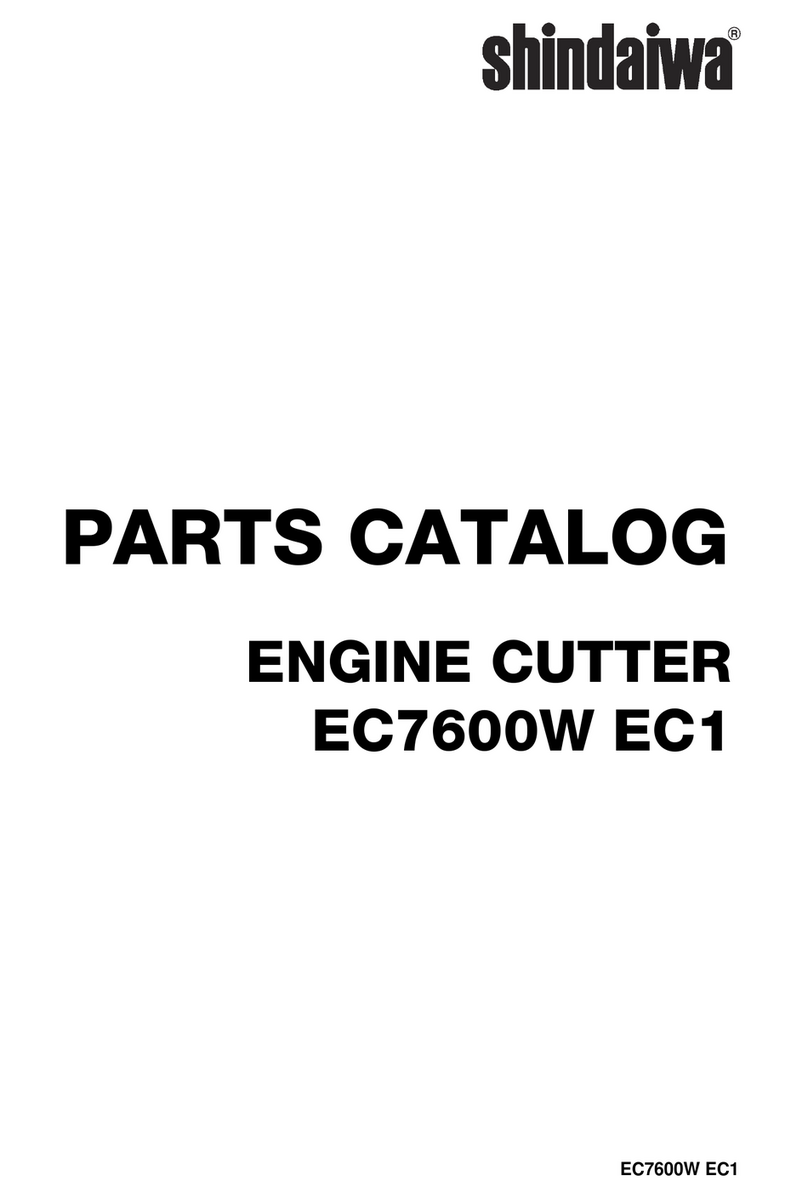
Shindaiwa
Shindaiwa EC7600W EC1 parts catalog
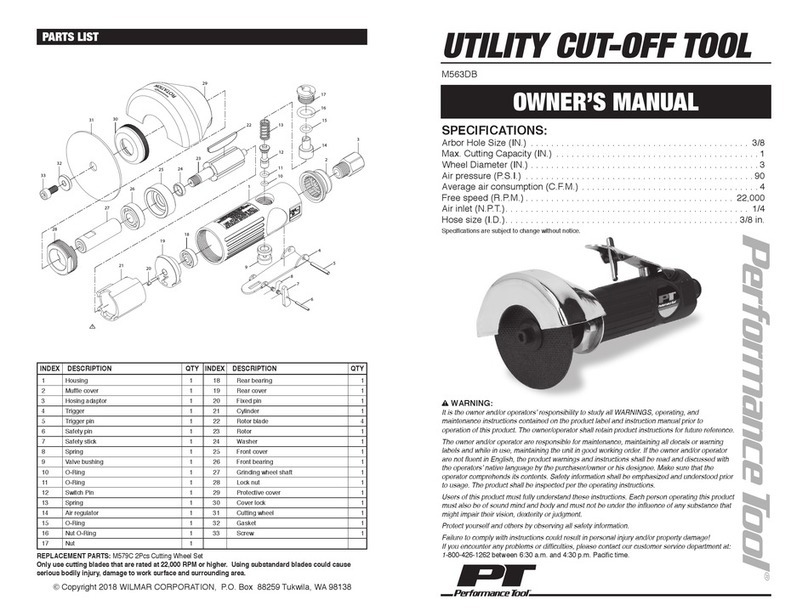
Performance Tool
Performance Tool M563DB owner's manual

Bosch
Bosch GOP Professional 30-28 Original instructions
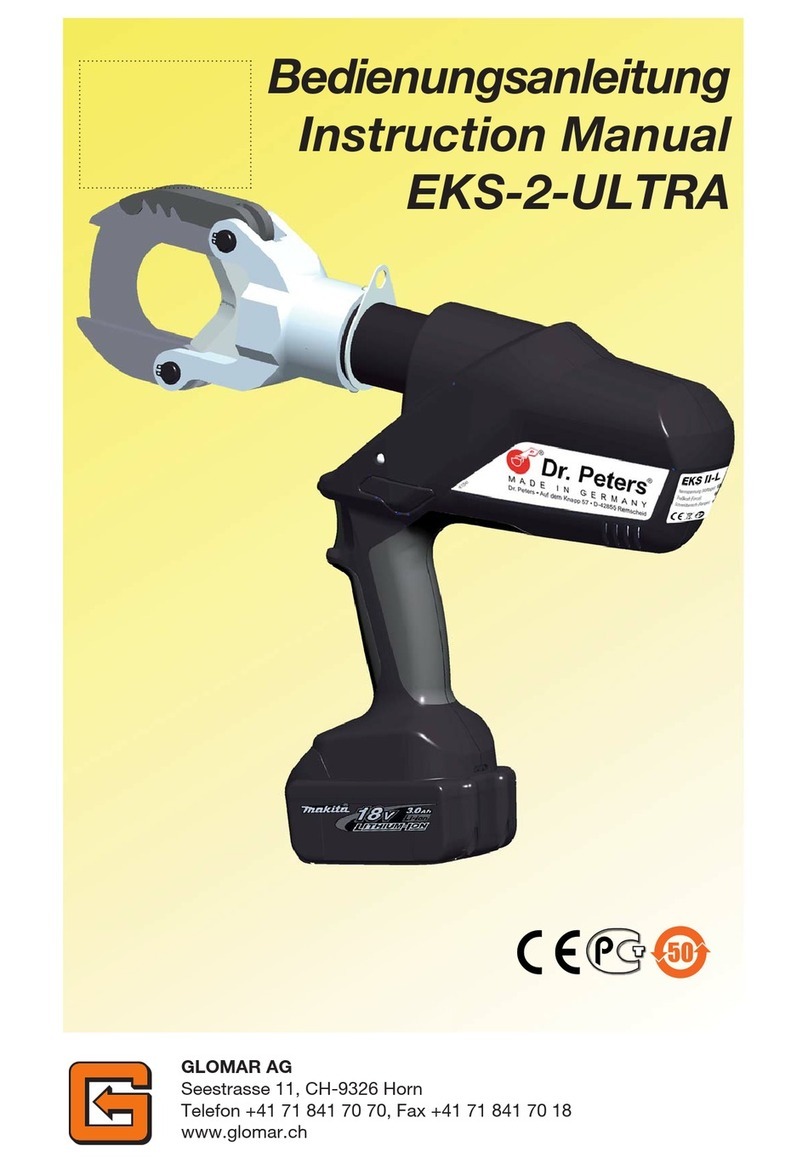
Glomar
Glomar EKS-2-ULTRA instruction manual

YATO
YATO YG-03100 instruction manual

